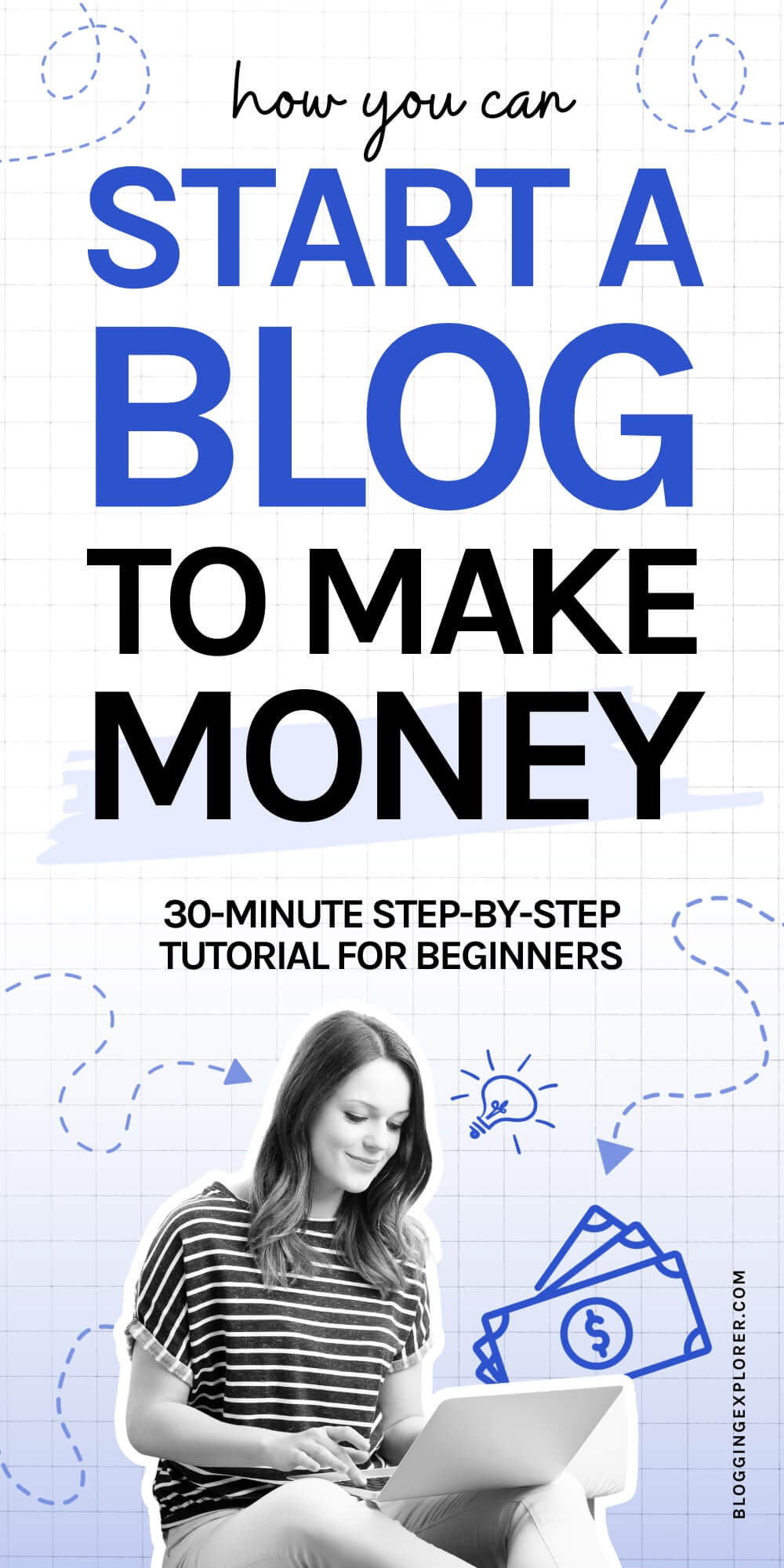So you want to learn how to start a blog in 2024? That’s awesome! If you’re looking to a step-by-step guide guide for beginners on how to start a blog, you’re in the right place.
Since 2016, I’ve been blogging and earning money online and today I’m going to show you how you can do the same. You will learn how to start a blog in 6 easy steps. It will take you about 30 minutes.
Click here to jump to the first step to start your blog now ↴
To make this guide to starting a blog today easy to follow, I’ve divided it into six parts you can walk through one by one:
How to start a blog (to make money) in 6 easy steps
In this guide, you will learn how to start a blog and make money online following these steps:
- Choose your blog topic and a name
- Get your blog online (web hosting and WordPress)
- Design your blog with a WordPress theme
- Write your first blog post
- Grow your blog traffic
- Make money online
All you need is a few moments of your time. And maybe a cup of coffee for a little extra boost.
Disclosure: Please note that this guide contains affiliate links to products I use and recommend. At no extra cost to you, I may receive a small commission for referring you. This helps me offer this guide free of charge for you and keep this blog up and running.
Save this post for later!

General FAQ: How to start a profitable blog in 2024 (without any experience)
A blog is a website that focuses mainly on written content called blog posts. Bloggers update their content regularly, publishing new blog posts to attract readers and earn money online. This website is a blog, too. And you are reading my blog to learn how to launch one of your own.
You can write about anything you like. That is the beauty of blogging – you are in full control over what you publish and share with your readers.
Whatever it is you wish to blog about, you can attract visitors from all over the world to your blog and connect with like-minded people everywhere. As a blogger, you can express your thoughts, share your experience with the world, interact with your readers if you choose to enable a commenting function, create an online community around a topic you love, and make money online. But most importantly, starting a blog allows you to connect with like-minded people from around the world.
No! Blogging is still very much alive and kicking this year. Blogging changed my life completely and I now make a full-time income from my two blogs. And I couldn’t be happier to share everything I’ve learned with you! Blogging is a surefire way to start an online business if you want to make money on the side and achieve financial freedom. In fact, starting a blog for money is one of the best ways to earn passive income these days. You don’t even have to create a product of your own to sell. We will look at a few popular ways you can make money blogging later in the guide.
Yes! Blogging is an easy way to launch your own online business and make money from anywhere in the world. You don’t have to be a skilled writer or web developer to become successful. You don’t need years of experience or a degree to create a profitable blog in 2024. Whatever you decide to blog about, you will attract readers, and you can start making money within days and weeks.
Yes! Blogging is one of the easiest ways to make money from home in 2024. Depending on your goals, you can start a blog to create a profitable side gig, or become a full-time blogger and start a successful online business. However, blogging is not a get-rich-quick scheme. It takes a lot of dedication and hard work to earn a full-time income from your blog. That’s why I created this quide for you – to make sure you’re not wasting your time on stuff that doesn’t work. The best part about blogging is that you have very low initial costs. I started my first blog with less than $40 for the entire first year, and it helped me build a full-time income from blogging – while still being just a side gig for me. I will show you how you can make money blogging using display advertisements, promoting affiliate products, and more later in the guide.
Yes! Even if you have no experience with websites, don’t worry. Starting a blog has never been easier than now. I created this guide for absolute beginners with zero technical experience. I will show you the exact steps you need to take so that you can learn how to start a blog today.
Many of us think that we need to be great writers to become successful bloggers. Luckily (at least for myself), this is not the entire truth. True, a blogger has to do some writing. But it’s not the writing alone that determines whether your blog will become successful. What matters more is the level of engagement of your readers. If you can offer your readers valuable blog posts they need, you’re on your way to becoming an all-star blogger already. People read blogs to learn new things or to connect with others with similar interests. They go online to find answers to their questions and solutions to their problems. With that said, the best (and only) way to become a successful blogger is to make your readers’ lives easier. Furthermore, you don’t have to be an expert or an authority on your topic of choice to become successful. Again, just remember that your blog should simply engage your readers. Pick a conversational and personal style to write, don’t worry about being an expert.
The cost for starting a blog in 2024 will be around $35.40 to cover your first year of fixed expenses. This includes the essential cost of web hosting, which I will walk you through in a minute. Throughout this guide, I will show you which blogging costs are absolutely essential and help you start a blog on a minimal budget.
While this guide is the first step to getting your blog started right now, my free 7-day email course breaks the entire process of starting a blog down into simple, actionable steps. It will help you go from zero to setting up your blog and learning how to write blog posts to growing your blog in just 1 week. I can’t recommend it enough.
If you want me to guide you through the simple 7-day process, let me know where to send your first lesson right away:
Step 1: Choose your topic and pick a name
The first step for starting a blog is to choose your topic and picking a name for your blog.
When you’re thinking about a good blog topic, there are two things to keep in mind:
- You need to be genuinely interested in your topic and show commitment. You will be spending a lot of time blogging, so make sure it’s something you enjoy.
- Your topic must help your readers and provide value to them. Your blog is not about you. It’s about your readers and your visitors who find your posts helpful, useful, and valuable. Find a topic that allows you to provide value to your readers.
Not quite sure what to blog about yet? No problem! There are a couple of easy and quick ways to find a good blog topic. Let’s have a look:
What to blog about? How to find the best blog topic?
You can blog about anything you like. Just make sure you choose a topic you enjoy researching and talking about.
Here are a few helpful blog topic ideas to get your creative juices flowing:
1: Hobby
You can write about a hobby that is close to your heart. You will never run our of ideas or feel like you don’t know enough about the topic.
Gardening, baking, travel, novels, fashion, cooking, you name it! Writing a blog about your hobby is a great way to connect with like-minded people around the world.
2: Passion
What is the one thing you can’t stop talking about? Why not start a blog about it?
We all have different interests and passions. For some it might be coffee, yoga, or politics, while others prefer tea, running, or green energy.
Whatever your passion is, it will help you stay motivated writing for your blog for years to come.
3: Yourself
We all have different views and experience regarding the most diverse topics possible.
You can start a successful blog about yourself living your life and sharing your thoughts with the world.
If you have a strong personality (not to the point of upsetting others), blogging about yourself can attract readers and fire up discussions that will help your blog gain even more momentum.
4: Family
We all come from different families with different backgrounds. There is something about reading someone else’s family story that sparks up our interest and attention.
Of course, you don’t have to go into too much detail and share private stories.
For example, one of the most popular family topics for blogging is pregnancy and everyday life once the new family member has arrived and turns the world around.
5: Life experience
We all have learned a bunch of lessons throughout our lives, good and bad. Blogging about what you’ve learned so far can help others deal with similar issues or hurdles, wherever they are reading your blog.
Sometimes the most simple of advice can help someone struggling with a difficult time in their life more than you can imagine.
But a life experience can also be something as simple as writing about how it is to be an expat in a foreign country or how your life has been since you decided to get married.
6: Lifestyle
Last but not least, writing a lifestyle blog is probably the most popular topic out there.
Fashion, beauty, makeup, interior design, travel, shopping, fitness… The list is long!
Lifestyle blogs can become incredibly successful in terms of attracting readers and making money by blogging if done correctly.
If this is is your thing, tag along and let’s start your blog right away!
My tip for choosing your blog topic:
Try not to overanalyze things when choosing your topic.
Beginner bloggers often get stuck in analysis paralysis. They overthink to the point where they feel so insecure about the whole thing that they just give up and forget about blogging altogether.
Don’t be one of them!
Just choose a topic you love, get your blog online, and start creating content by putting your heart into every blog post you create. That’s all there is to it!
Ok, so you got your topic sorted? Great! Next, it’s time to choose a name for your blog.
How to choose a name for your blog?
Once you’ve found the perfect blog topic, it’s time to choose a name for your blog.
It’s the first thing your readers see when they visit your blog, right? Therefore, think about the name from your readers’ perspective. Can they tell what your blog is about just by reading the name?
For example, I chose to name my blog “Blogging Explorer”. Clearly, this blog is about blogging. And it’s about discovering practical ways to start a successful blog from scratch.
That being said, your blog name should be:
- Unique and clear:
Choose a name that you can relate to and that your readers can understand. If you blog about food, for example, try to include a food-related word into your blog name. - Descriptive:
Your blog name should tell your readers what your blog is about the first time they see it. - Easy to spell:
Choose a name that is easy to write and spell. My rule of thumb is: you should be able to tell it to someone at the coffee shop without them having to ask how it’s spelled. Chances are that they will look for it on Google, so they need to be able to type the name of your blog correctly.
Brainstorm 3–5 name ideas right now.
Next, you need to choose a domain name extension. The most preferred domain extension is “.com”. Also, “.org” and “.net” are popular.
If you want to write for readers in a specific country, consider choosing a country or language specific domain extension like “.fr” for a French blog or “.de” for a blog in German.
Now that you have some name ideas and a domain extension chosen, it’s time to get your blog online.
This might seem a bit scary or technical, which is why the step-by-step guide below will walk you through every step to make things easy for you. It’s easier than you think.
Step 2: Get your blog online (Domain name and blog hosting)
The second step in starting a blog is getting your blog online. That’s what a web hosting company will do for you.
In this step, you’ll select the web hosting plan and the blogging platform you’ll use to get your blog online.
The combination of web hosting and blogging platform I use (and that most other bloggers use) is a WordPress blog hosted by Bluehost. This combination is what we’ll be using to start your blog.
WordPress is a free publishing platform that’s been around since 2003 and now powers more than 60% of all blogs worldwide.
Bluehost is one of the most established, reliable companies available for blog hosting. Since 2005, WordPress recommends Bluehost because of their customer service and expertise, too.
How to create a Bluehost blog hosting account
Click here to get to Bluehost and click “Get Started Now”:
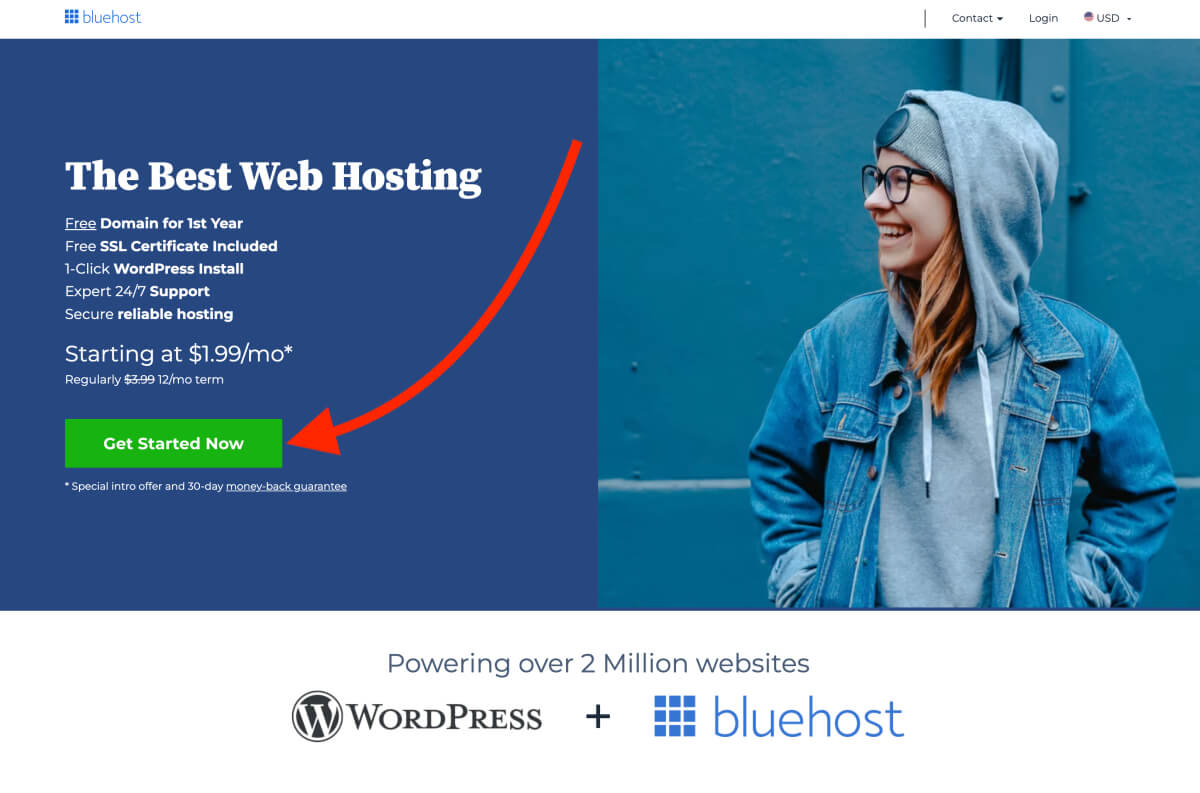
Next, you’ll select your hosting plan. I recommend starting with the most affordable option. You can upgrade to a higher-tier plan in the future if you need to. Choose the “Basic” plan on the left by clicking on Select:

Any of these plans will be great for starting a blog, so you can’t go wrong with any of them.
Choose your blog’s domain name
On the next page, just type in the name of the domain name that you’d like your blog to have (mine is bloggingexplorer.com).
If your domain name is taken or you can’t think of one just yet, I suggest you select I’ll create my domain later at the bottom of the page. You can brainstorm ideas once your account is set up and you have a clear head.
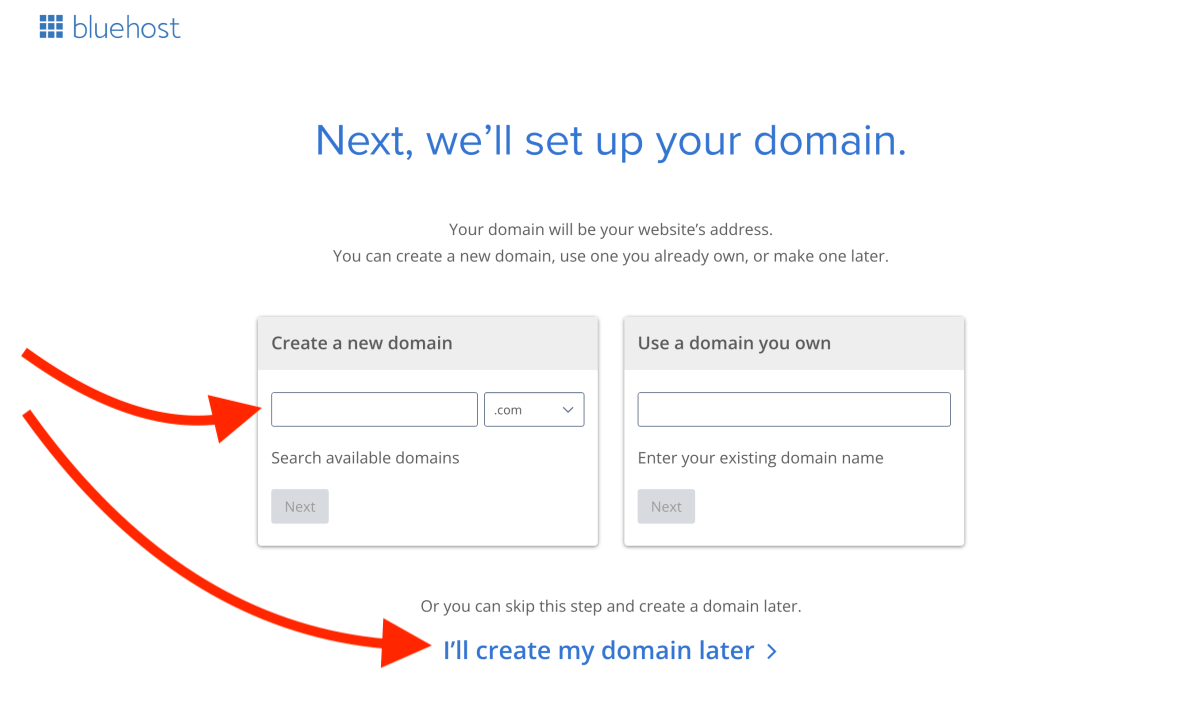
Create your Bluehost account
Next, you’ll be taken to the final page for creating your account, finishing up the Bluehost signup process:
Fill in your account information
First, fill in your account information like name, email address (use your primary email address, because that is where your login details will be sent) and address:
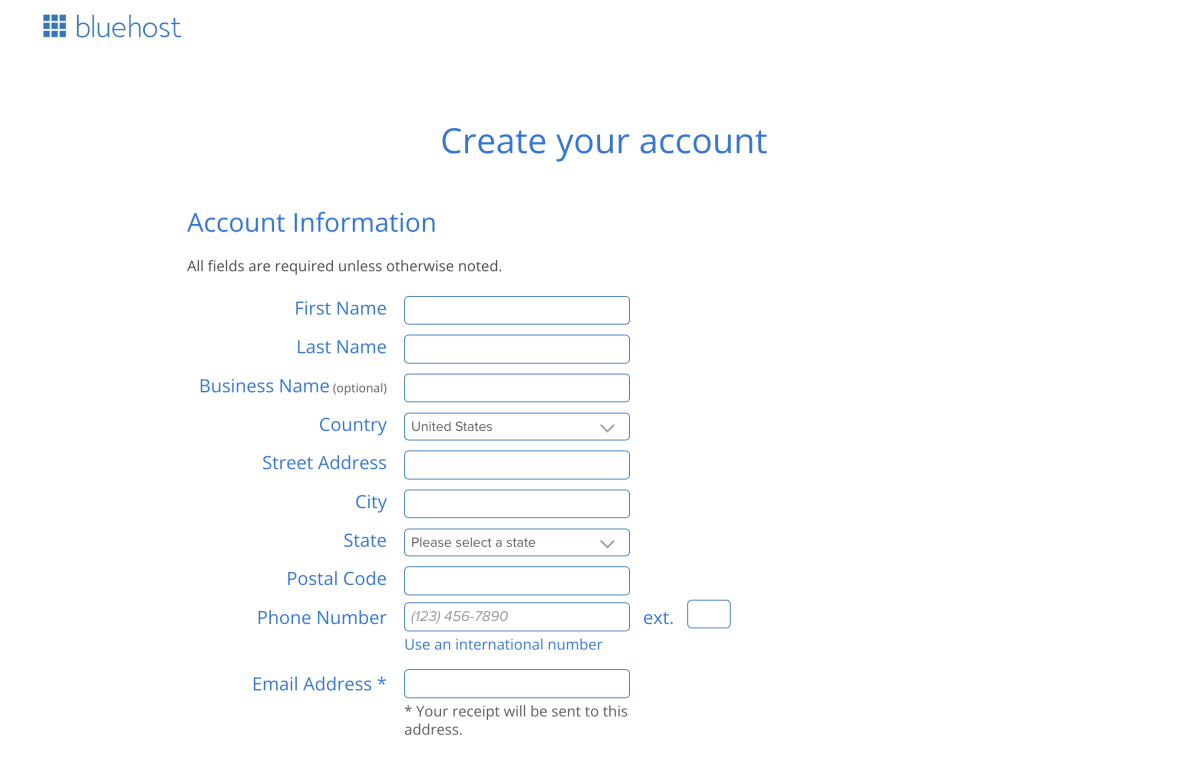
Choose the right hosting package
Next, choose your plan duration based on which price you want to secure and how far in advance you want to pay (either 12 or 36 months in advance) under Service Term:

I recommend picking one of the longer plans if you want to lock in the lowest price for your blog hosting. I started with the 36-month option. It gives you the blog hosting at the lowest possible rate for the next 3 years.
Keep in mind that the low pricing only applies to new customers and the first payment you make. If you choose a shorter plan, your pricing may go up after the first year.
Choose a plan that suits your budget. If you’re ready to commit to starting a blog to make money, it’s a good idea to opt for a long-term package.
Select package extras (you don’t need any of them)
Thirdly, you can choose some additional services for your blog under Package Extras:
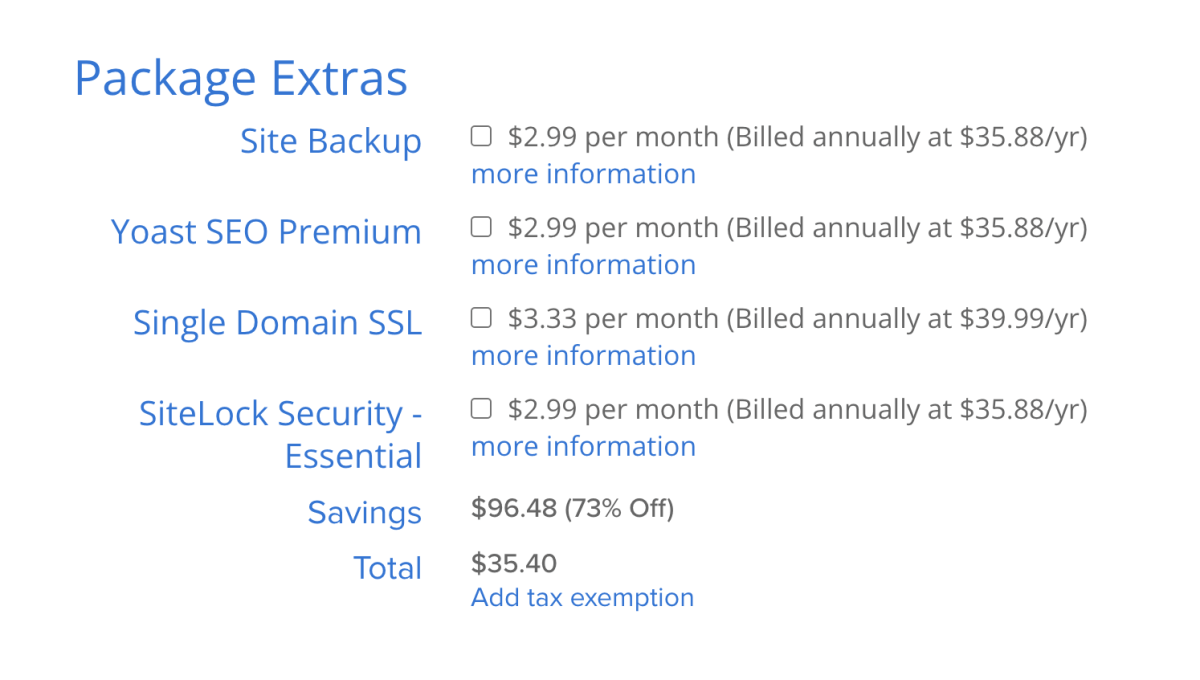
If you ask me, you don’t need any of them. Seriously.
The total price you see is the amount you’ll pay now. But keep in mind: you won’t have to pay again for 1 to 3 years depending on the plan duration you chose earlier. Also, remember that Bluehost offers a full 30-day money-back-guarantee in case things don’t work out as you planned for your blog.
Enter your payment information
Finally, enter your payment information, read the terms, and hit Submit:
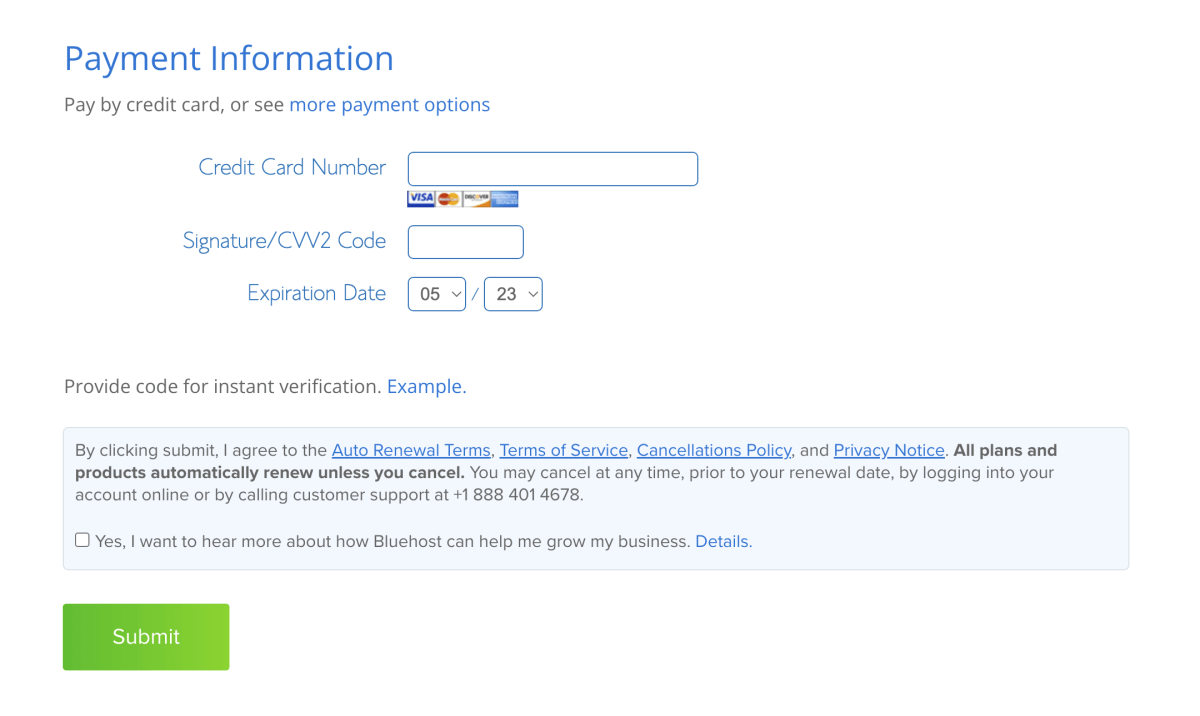
Congratulations! You’re now officially a happy member of the Bluehost community with your very own web hosting plan.
You will receive an email from Bluehost with your receipt and your account details like your username and password for logging in to your Bluehost dashboard. Make sure to save that email.
Finish setting up your Bluehost account and WordPress blog
Once your payment has been processed, let’s finish creating your Bluehost account and get your blog fully set up.
On the page you see after finishing your payment, click on Create your account:
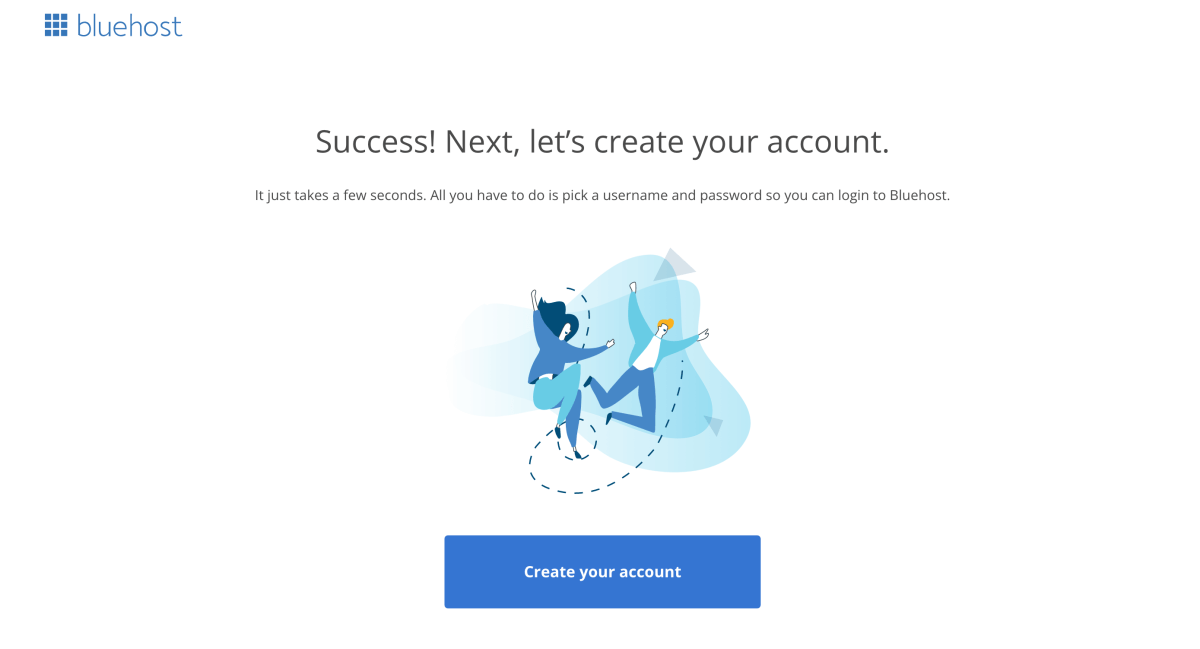
In the next step, create your password for your account, and read and agree to the Privacy Policy and Terms of Service:
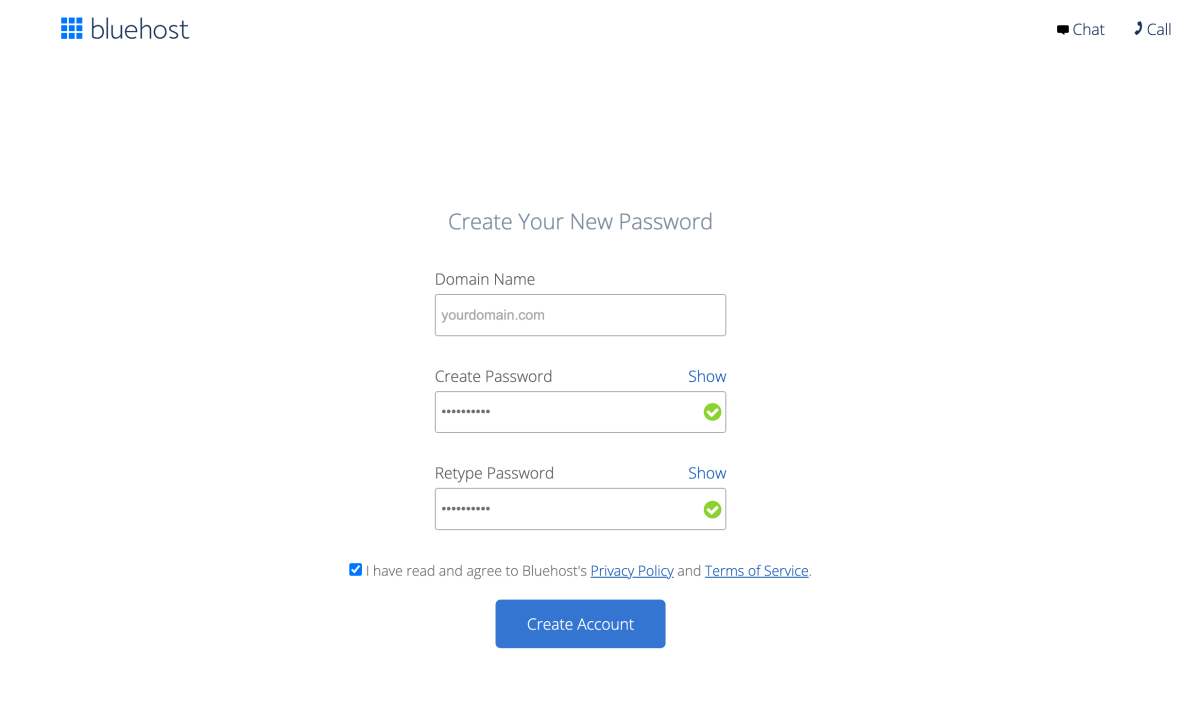
On the next page, it’s time to create your blog website. Click on Create your website to get started:

Next, you can select how much help you want with building your website:

- No help needed: You can get in touch with the support anytime.
- A little help: You get step-by-step guidance, tips, and to-dos.
I suggest you skip this step. If you choose “A little help”, you can select the purpose of your site in the next step. Choose “Blog”:

Next, you can select the type of your blog and who you are creating it for. I suggest you click Skip this step at the bottom:

Next, you can enter the name and tagline for your site. You can change these later, so feel free to select Skip this step at the bottom if you don’t have a clear name and tagline in mind:
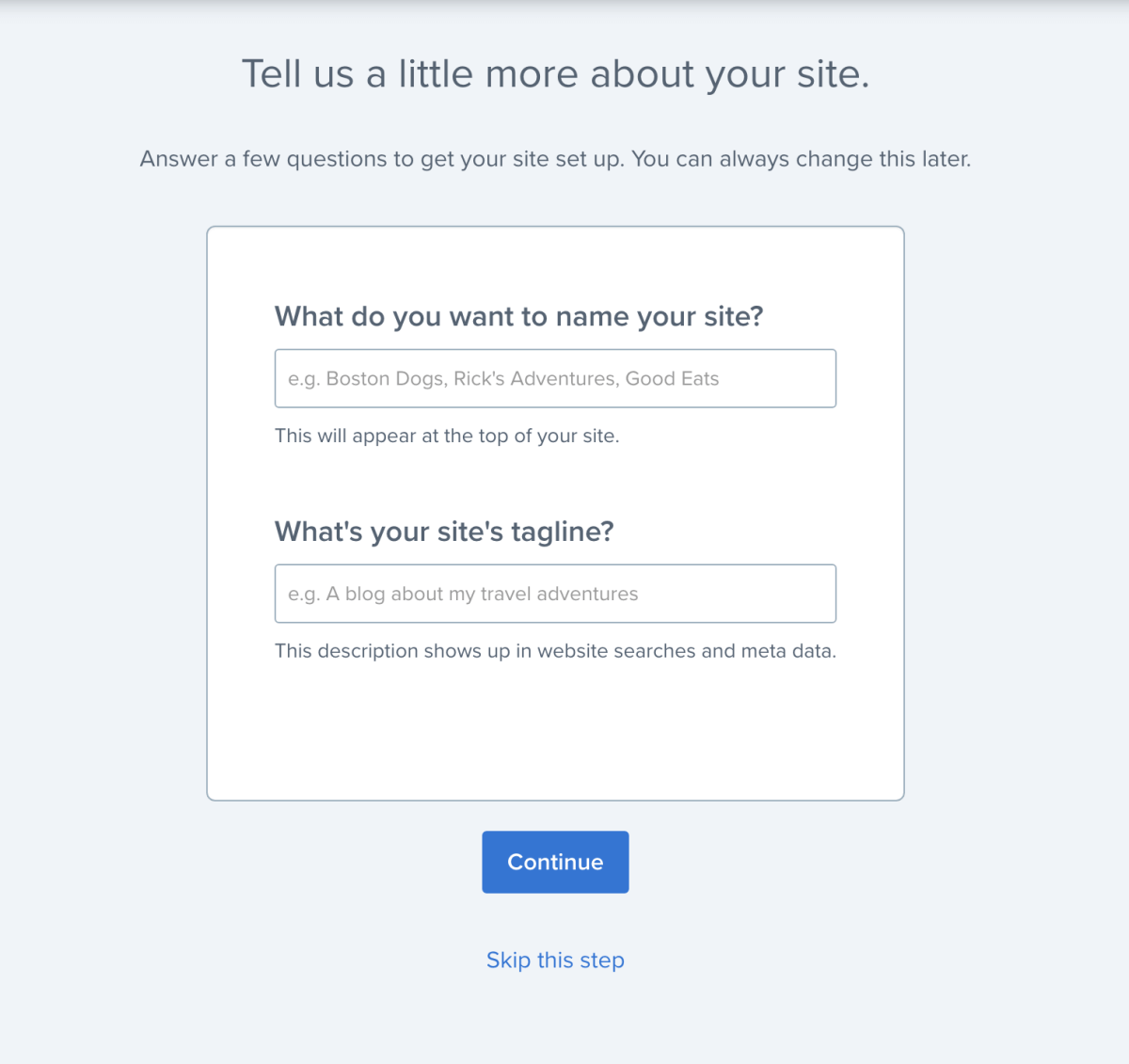
On the next page, you can choose a WordPress theme for your blog. We’ll look at themes later in the guide. Scroll down to the bottom of the page and click Skip this step:
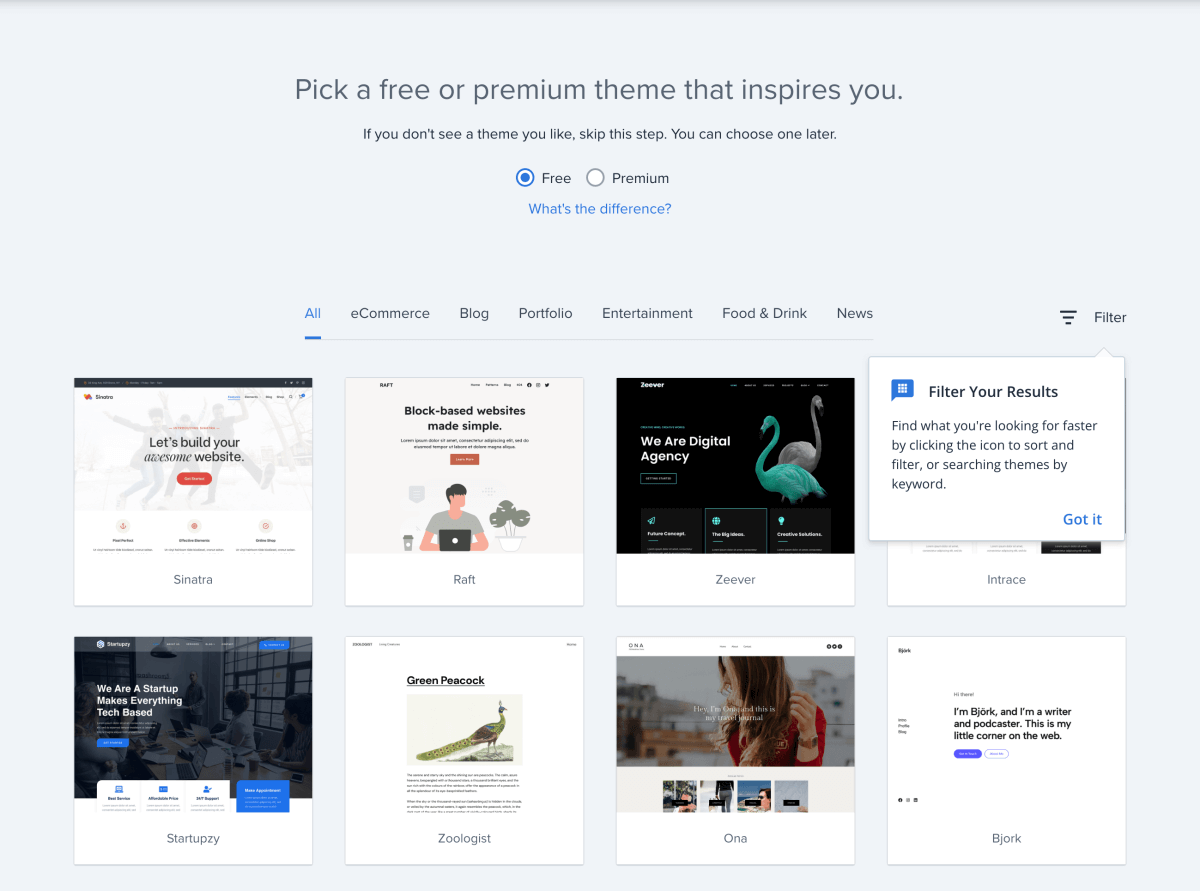
Bluehost will now install and configure WordPress automatically for you in the background.
Once everything’s done, you will be taken to your Bluehost Portal, which is the main dashboard for managing your Bluehost account:
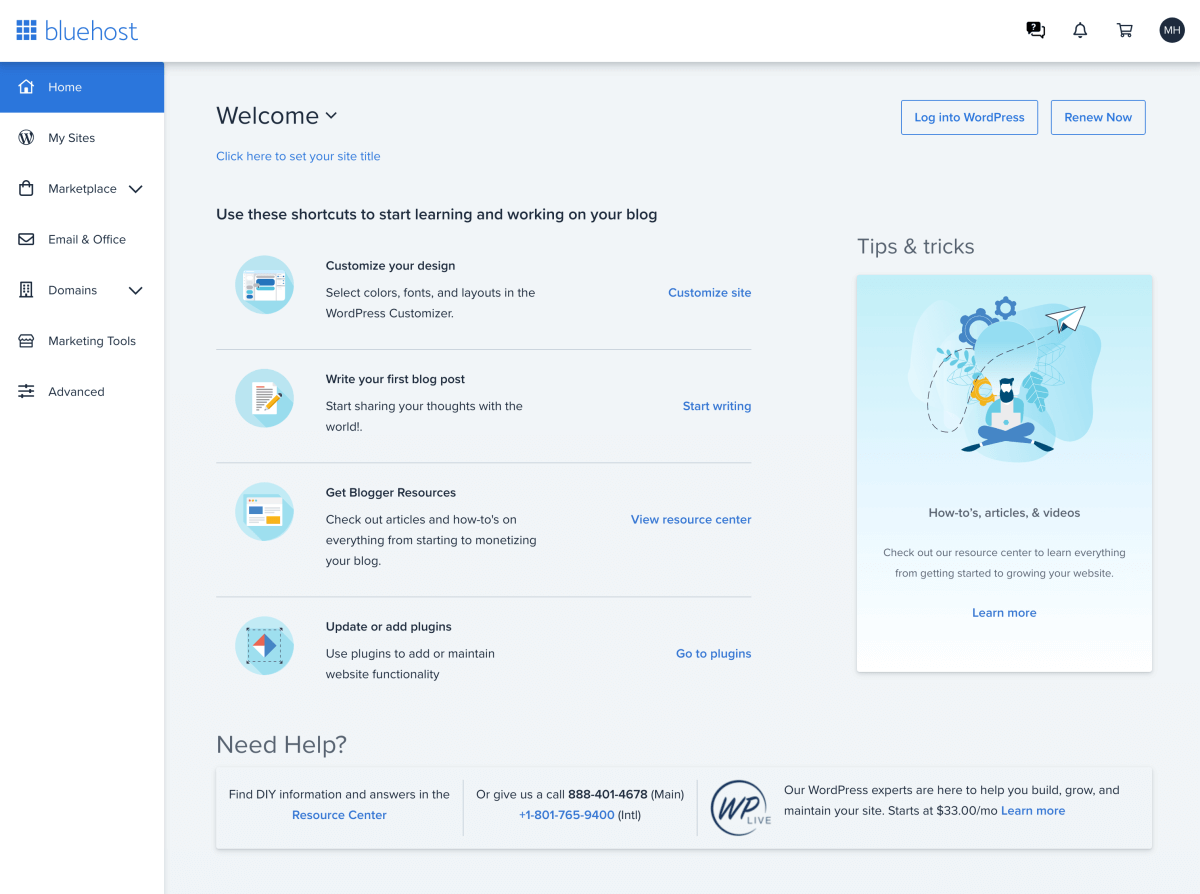
With the left-hand side navigation, you can access and manage your sites, email addresses, domain names, and more.
You also have a few tools for managing your WordPress blog here. However, I recommend doing anything WordPress-related directly in your WordPress dashboard, which is built into the WordPress blogging platform you will be using. You want to get familiar and comfortable with WordPress itself, so try to work in the system as much as you can.
Now is a good time to bookmark this URL for logging into your Bluehost Portal.
Log into your WordPress dashboard
To access your WordPress dashboard through your Bluehost Portal, click on Log into WordPress:

Your WordPress dashboard will open in a new window. This is where you can access and manage everything on your blog website:
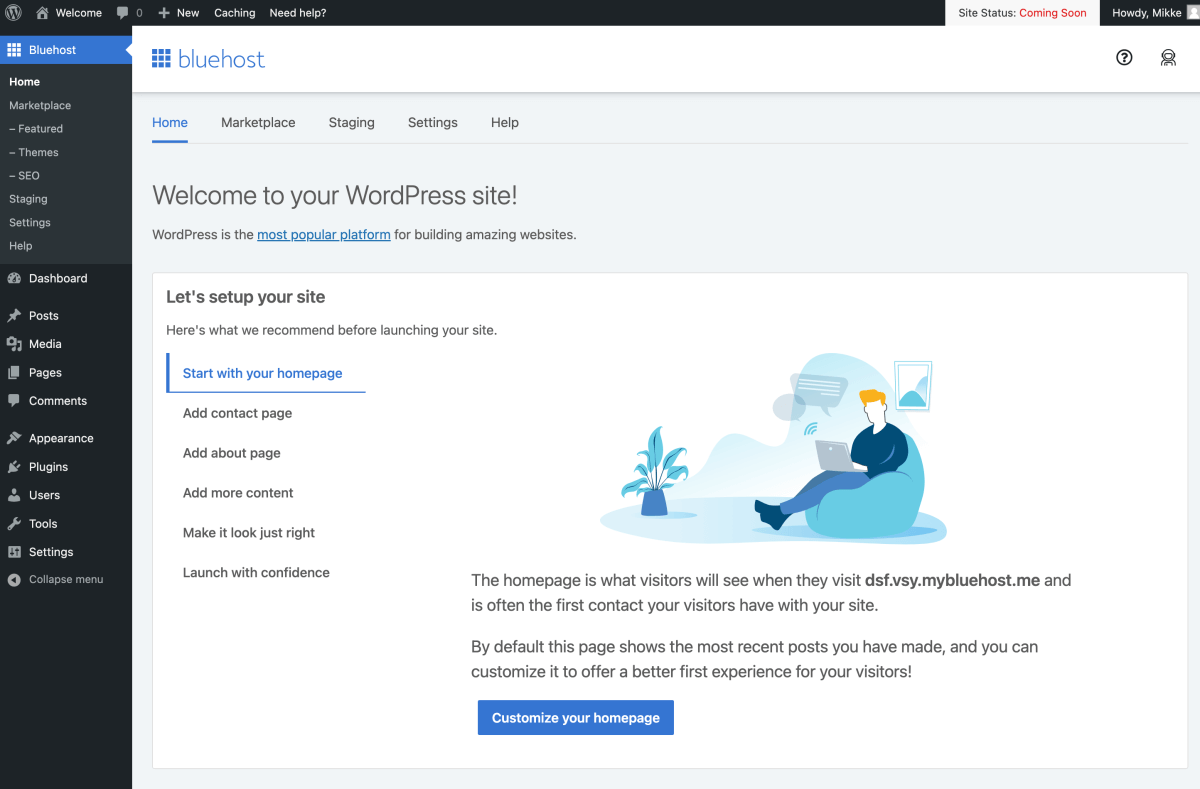
The dashboard has a lot going on, so take a few moments to get your bearings.
The left-hand side menu is your main navigation. You will use it to manage the most important parts of your blog:
- Posts
- Media
- Pages
- Comments
- Appearance
- Plugins
- Settings
Familiarize yourself with the admin area of your WordPress blog step-by-step. You’ll spend a lot of time here and gradually build a deeper understanding of how WordPress works. You will also quickly learn how to change the appearance of your blog and add new features like contact forms or social media sharing buttons.
Access your WordPress dashboard via your domain name
As we saw above, you can access your WordPress dashboard via your Bluehost Portal. But you can also log into your WordPress blog website directly by using your domain name.
The default login URL is your domain name with “/wp-admin” added to the end of it.
For example, if your domain name is myblog.com, your login URL is “myblog.com/wp-admin”.
To log in, enter your WordPress username and password, and click Log In:
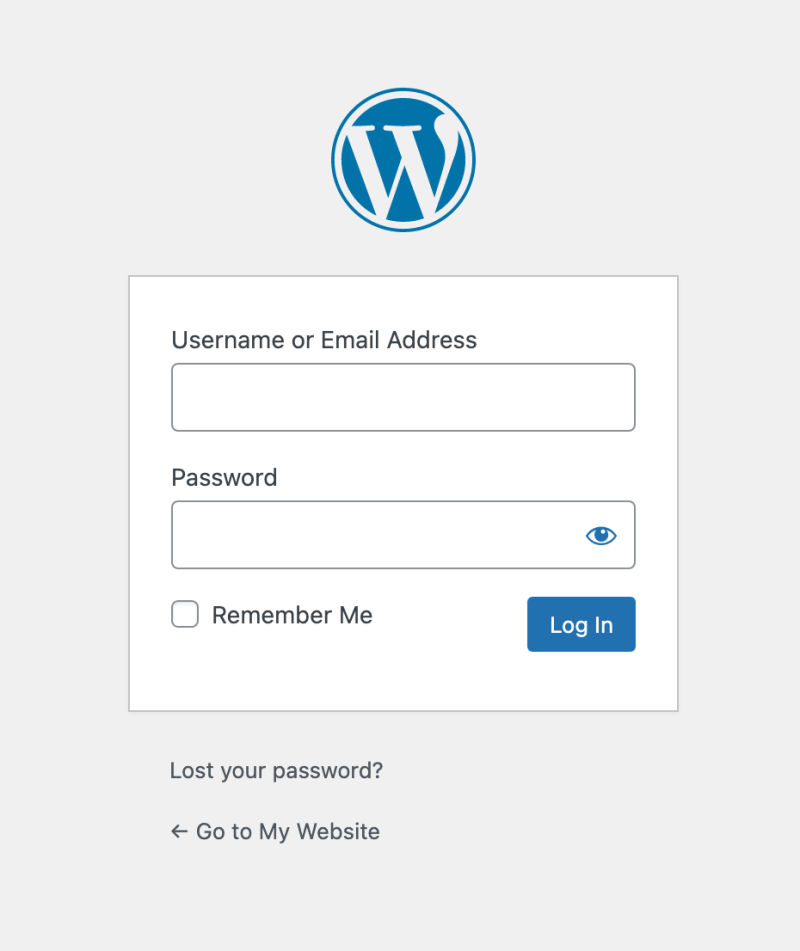
Step 3: Customize your WordPress blog
You’ve finished the technical part of starting a blog, congrats! Now it’s time to have some fun and customize your WordPress blog to look amazing.
In WordPress, the templates that determine how your blog will look like are called “Themes”. Your WordPress theme controls the entire design and layout of your blog.
When you are new to blogging, I recommend sticking to free WordPress themes in the beginning. Learning how to use a premium theme may feel overwhelming at this point, and you don’t want any distractions right now.
Once your traffic grows and you’ve published a handful of blog posts, you can consider investing in a paid premium theme.
So right now, your top priority is to write awesome blog posts to bring visitors to your blog.
How to choose a WordPress theme for your blog
When you start a blog following the steps above, your WordPress website comes with a few pre-installed default themes. Hence, your site already looks great, so you can simply leave it as it is. You can always come back and switch to another theme later.
To pick a free theme, head over to Appearance > Themes > Add New > Popular:
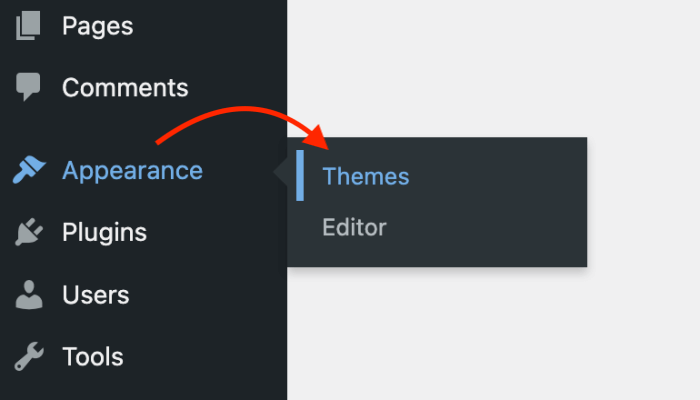
You want a WordPress theme that’s beginner-friendly, clean and clear, and easy to set up. Right now, you want to avoid advanced-level themes with too many bells and whistles.
I recommend Astra or Hello Elementor (with the powerful Elementor page builder) – both are 100% free blog themes. They are easy to use and they load super fast. Plus, you have the option to upgrade to an affordable premium version in the future.
I use Astra and Elementor for this website — just in case you want a similar, easy setup for your blog.
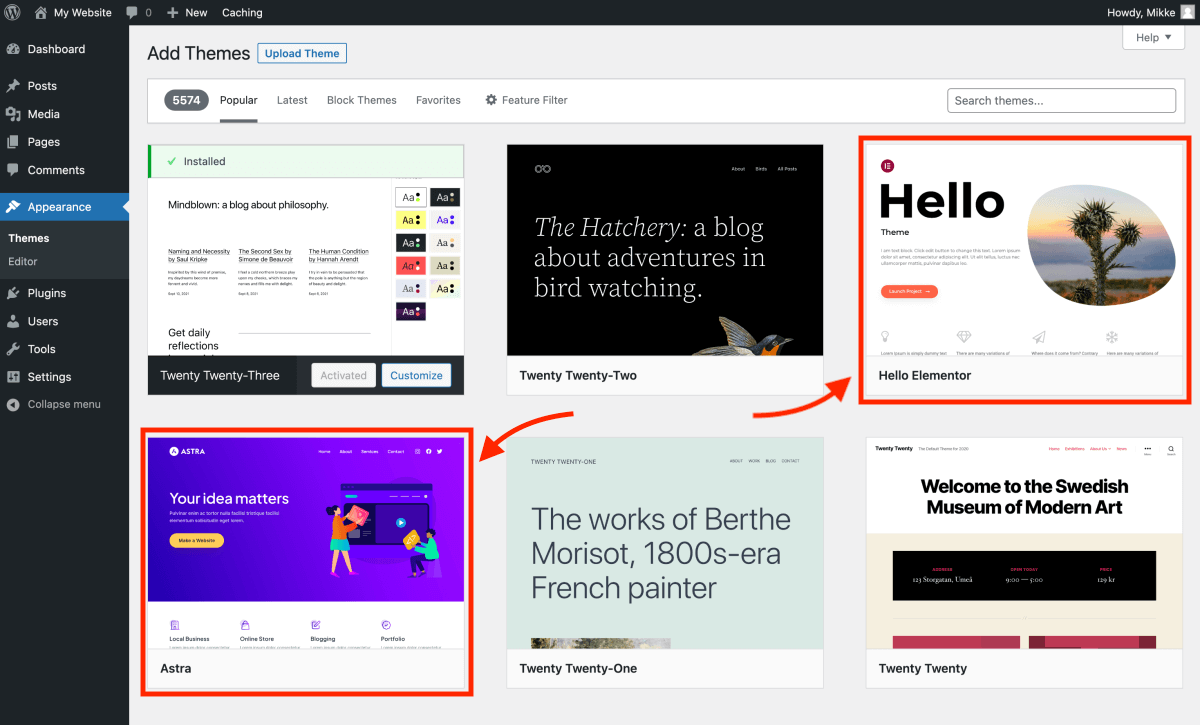
Hover over a theme you like and click Install:
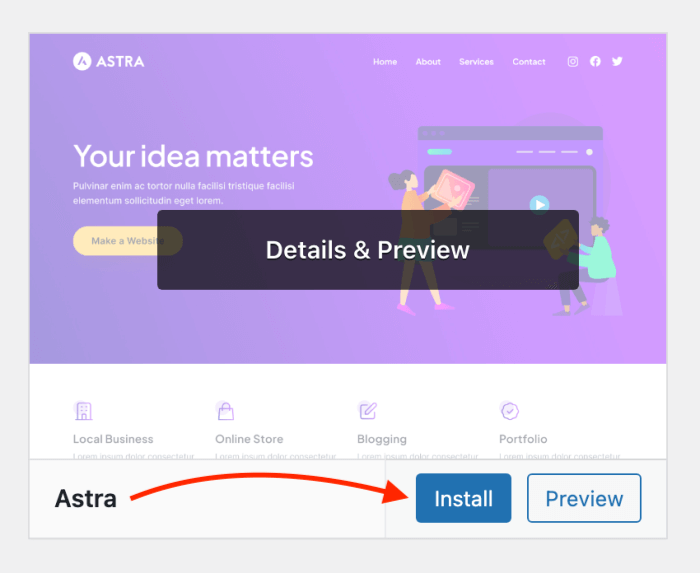
Once the installation is complete, click Activate:
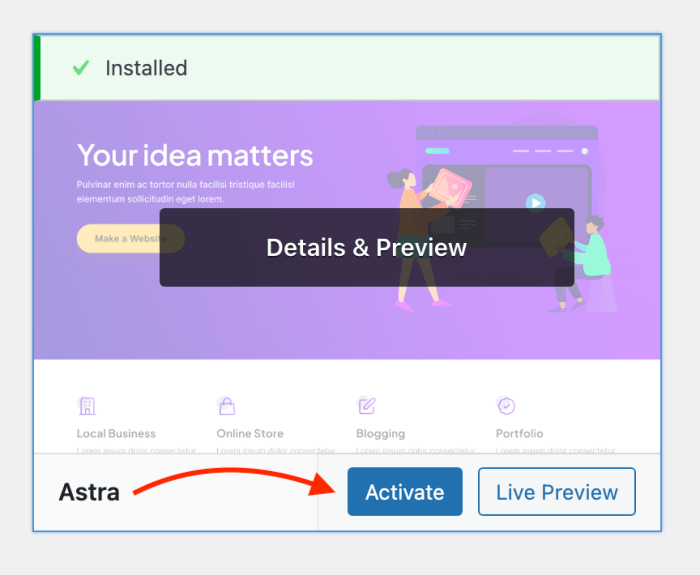
And that, my friend, is how you install a WordPress theme for your new blog!
Now you can admire the new look of your WordPress blog. Hover your mouse over the name of your blog in the upper left corner of the screen and click on Visit site to see the newly-designed start page of your blog:

Congratulations! You just changed the design of your WordPress blog like a pro!
Once you’ve selected and installed a theme, it’s time to look at customizing your WordPress blog even further with WordPress plugins. Whereas themes allow you to change the design of your blog, plugins add new features and functionalities to it.
7 must-have WordPress plugins for your blog (install them right away)
WordPress plugins are a crucial part of starting a blog and adding important features. Plugins make your life easier, help your readers enjoy your blog even more, and improve your search engine rankings.
But a word of warning: Installing plugins blindly can cause all sorts of problems for your blog. Only use plugins that are 100% necessary. “Nice-to-have” plugins are usually a bad idea.
To help you find the right plugins and avoid problems, here are the most crucial WordPress plugins to install when you start a blog:
- Yoast SEO: The more visitors you get, the better chances you have at building a successful blog that makes money. The Yoast SEO plugin helps you optimize your content so that search engines can find your blog and display your content to your target audience in their search results.
- UpdraftPlus: Sometimes things can go wrong and you may need to restore a backup of your blog to fix things. UpdraftPlus is the best free WordPress backup plugin that allows you to save your work and restore a past version of your blog when needed. I know most bloggers don’t even think about backing up their work, but you’ll be glad you installed this plugin.
- Elementor: Elementor is a powerful page builder tool that allows you to customize your blog design and build beautiful page templates for your blog posts. I use Elementor for most of my website projects these days and I can’t recommend it enough. It’s one of the most popular WordPress plugins worldwide – for a good reason.
- Antispam Bee: Antispam Bee is the best free anti-spam plugin for WordPress. It filters out and blocks all spam comments for you. This plugin saves you heaps of time and helps you keep your blog clean.
- Insert Headers and Footers: Sometimes you need to add custom code snippets to your blog. For example, if you want to track your visitors, you need to embed a snippet from a tracking tool like Google Analytics. Insert Headers and Footers allows you to do just that – within seconds.
- WP Rocket: Fast-loading websites rank higher on Google and generate more free traffic. WP Rocket is a plugin that speeds up your website by caching your blog pages, reducing your file sizes, and much more.
- Email Address Encoder: Chances are you want to publish your email address on your Contact page to help your readers get in touch with you. Unfortunately, spammers will soon find that address and your inbox will be flooded with spam emails. The Email Address Encoder plugin encodes your email address so that bots can’t find, harvest, and use it for spamming.
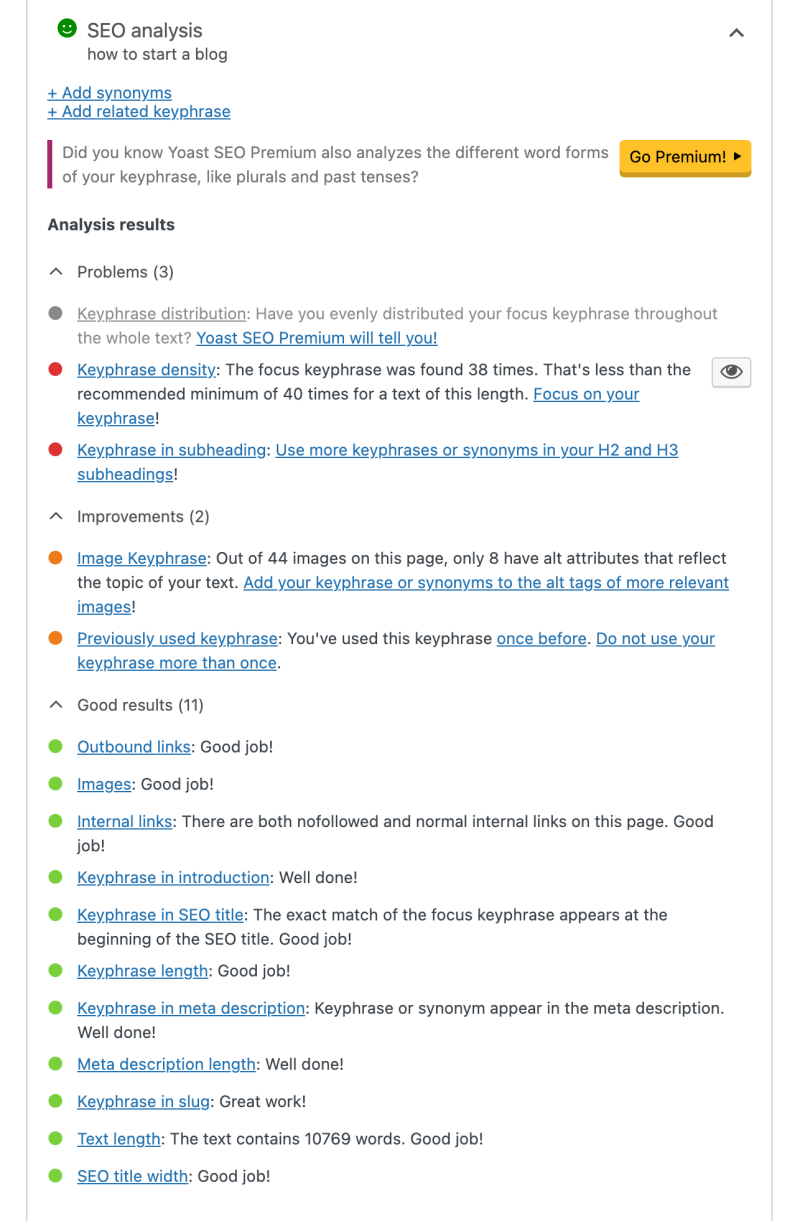
How to install a WordPress plugin: Step-by-step guide
The easiest way to install a WordPress plugin is through your WordPress dashboard. To get started, make sure you’re logged into your WordPress blog and follow these steps:
Step 1: Head over to Plugins > Add New
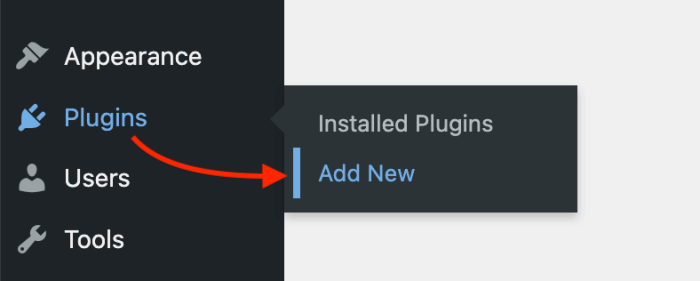
Step 2: Search for the WordPress plugin you need
In your WordPress plugin directory, use the search field at the top right to find the plugin you want to install:
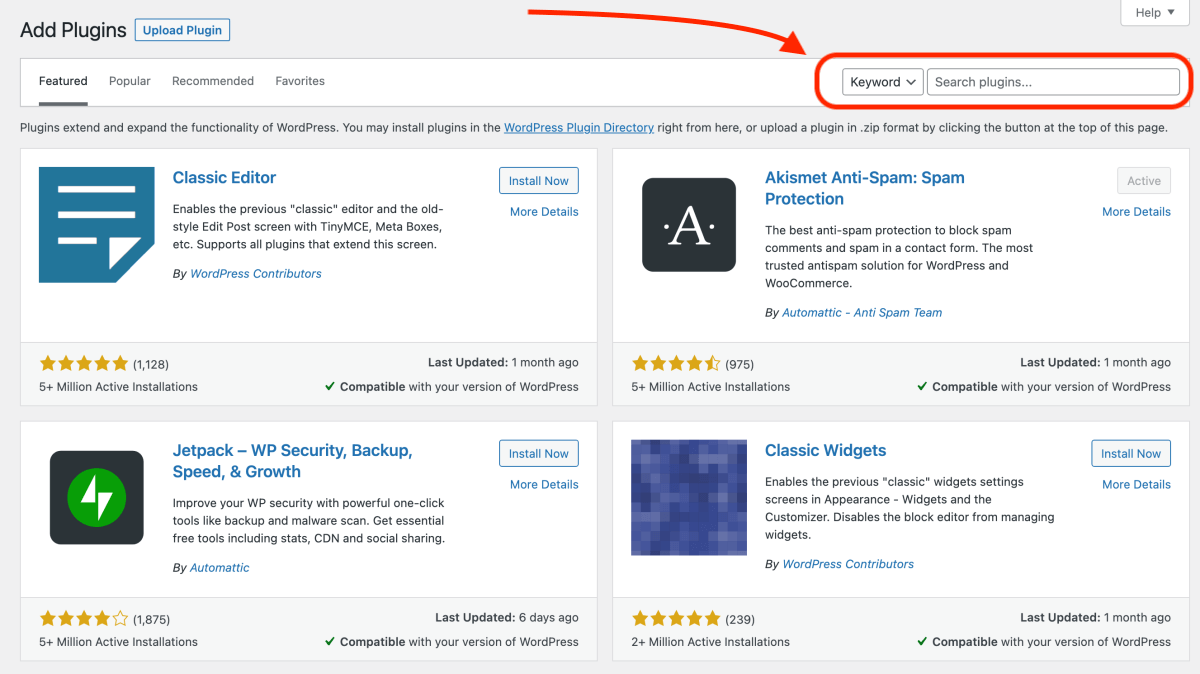
Step 3: Click Install Now
When you’ve found the WordPress plugin you want to install, click the Install Now button:
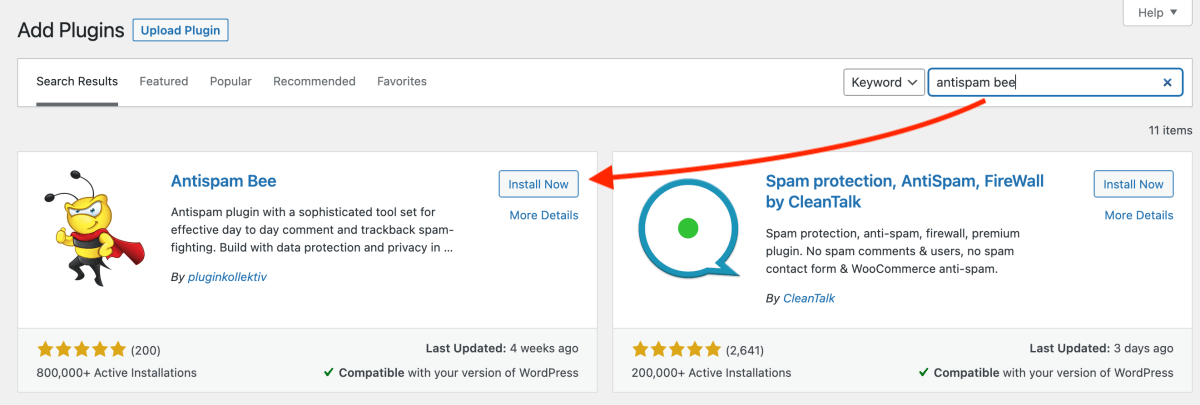
Step 4: Click Activate
Once the installation is complete, activate the WordPress plugin by clicking Activate:
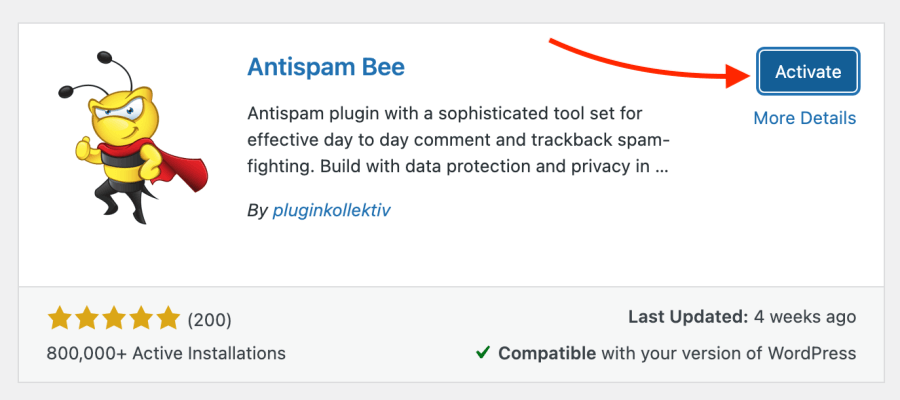
Once the plugin has been installed and activated, you can start using it right away.
How to create an About page for your blog
As soon as you start a blog, you want to create an About page for your blog where you showcase some basic information about yourself. This includes who you are, why people should listen to you, and how they can reach you for queries or collaborations.
Hence, your About page is like your blog’s introduction. It’s where you introduce yourself to your readers and showcase your expertise, personality, and purpose for creating your blog.
When you are new to blogging, writing a great About page can feel difficult and daunting. To help you get started, here’s a step-by-step guide on how you can create an About page that achieves these objectives for your blog.
- Introduce yourself: Start by introducing yourself and give a brief background of who you are. Your name, where you’re from, and what inspired you to start a blog.
- Share your mission statement: Let your readers know the purpose of your blog. What topics will you cover? Who is your target audience? What do you hope to achieve with your blog?
- Highlight your expertise: Share your credentials and qualifications that make you an authority in your niche. If you don’t have any formal qualifications, explain why you’re passionate about your topic and how you’ve gained knowledge through personal experience.
- Share personal details: Make your blog personal by sharing a little about your personal life. Talk about your family, hobbies, or anything else that gives readers a glimpse into your life.
- Showcase your personality: Let your readers get to know your personality. Are you funny? Sarcastic? Compassionate? Showcase your personality through your writing style.
- Include a photo: Use high-quality photo of yourself to make your about page more visually appealing. This also helps readers put a face to the name. You don’t need a professional headshot for this. Use your phone, make sure the lighting is good, and ask a friend to take your photo.
- Provide contact information: Make it easy for your readers to get in touch with you. Add your email address on your about page or create a simpel contact form with Elementor or the Contact Form 7 plugin, for example.
- End with a call-to-action: Finally, encourage your readers to take action. Share links to your best content or ask them to follow you on social media, or getting in touch with you.
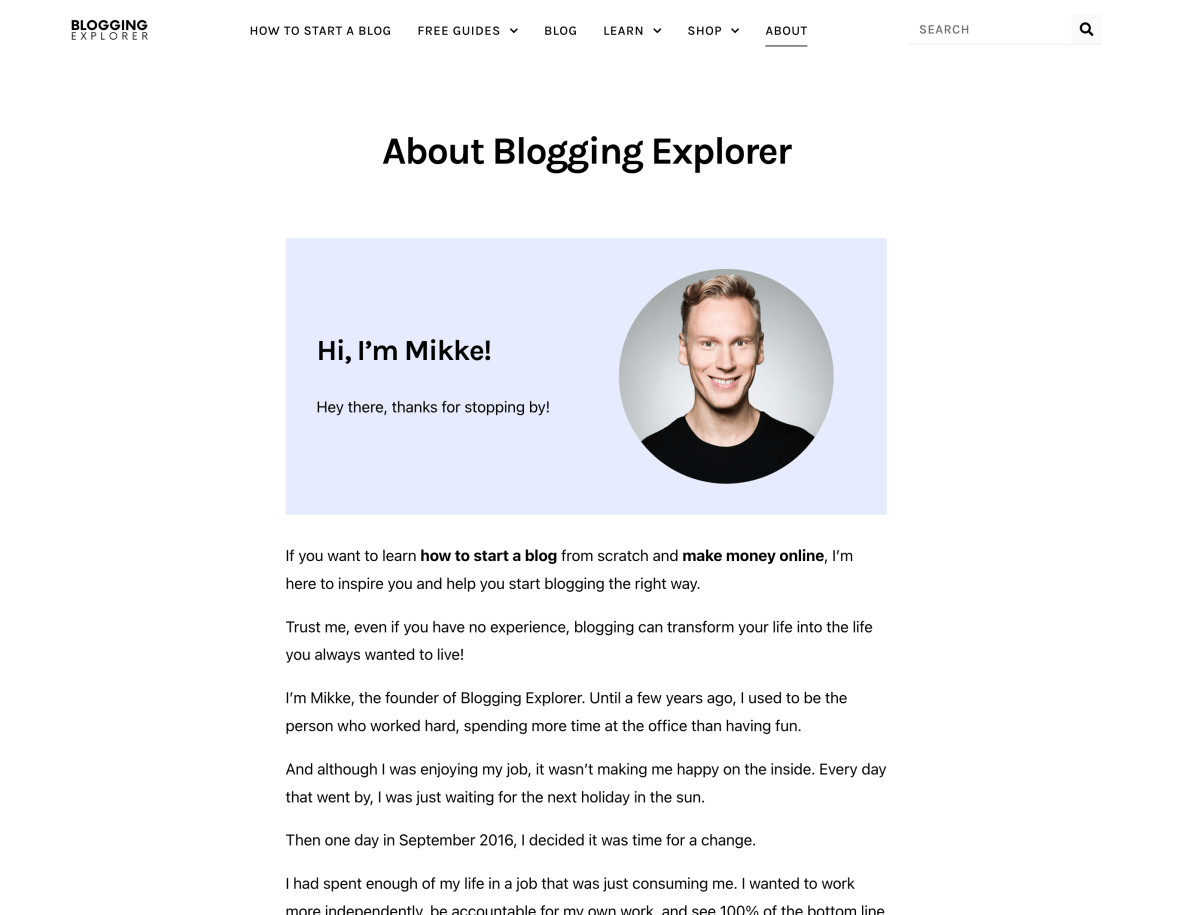
Remember, your About page is your chance to make a great first impression and connect with your readers. Keep it engaging, informative, and personal to set the tone for your blog. Don’t overthink it – just follow the steps above and you’re all set!
Step 4: Write your first blog post
Why do you read a blog?
You don’t read a blog because it looks nice.
You read a blog because you care about what it says. You are interested in the content.
Creating high-quality content is what will bring you readers, helping you to eventually earn money blogging.
Before you start planning your content calendar and writing your first blog post, you need to answer one simple question: Why?
- Why did you choose your blog topic?
- Why do you care for it?
- Why should other people read your articles?
- Why is this a blogging topic you can add value to?
Take time to answer these questions. Remember what made you want to start a blog in the first place. Again: Why?
I always emphasize the importance of picking a clear niche. It helps you focus, keeps you motivated, and makes it easier to monetize your content. For some quick inspiration, check out my full list of profitable niches to blog about.
What should you write about?
To help you find a topic you are interested in, here are a few helpful questions:
- What is your favorite topic to talk about with your friends or family?
- What do you enjoy doing the most in life?
- When you have the feeling that time is just flying by, what are you doing?
- What do you do in your free time? What are your hobbies?
- What topics do you know a lot about?
- What do you enjoy learning about the most?
And finally, my favorite question:
- What’s the one thing you just can’t shut up about?
Don’t get too hung up on finding the perfect topic right away. Take some time to brainstorm ideas – the more ideas you find, the better.
Remember: You must solve a real problem for readers
If you want to make money with your blog, you’ll also want to do some quick research to see if there is a market demand for your niche. You want to find out if people are actively searching for what you’re writing about.
The only way to create a business from your blog is to solve a real problem for people. To do this, you need to understand who your blog target audience are. Once you know their pain points, you can start creating helpful content that answers their questions and make their lives easier.
How to come up with blog post ideas?
Try these methods to generate some unique blog post ideas:
- Brainstorm blog topics: Start with 5 minutes and write down as many ideas and keywords as you can. Think about your target audience: What problems are they struggling with? What questions are they asking?
- Use a keyword tool for more ideas: Gather additional ideas using free keyword tools like Moz, WordStream, or Google Trends. These tools show you how much traffic specific keywords are getting, i.e. how much market demand there is.
- Gather your ideas in a spreadsheet: Time to put all your ideas together and prioritize. Low-difficulty keywords are great to start with when your blog is new.
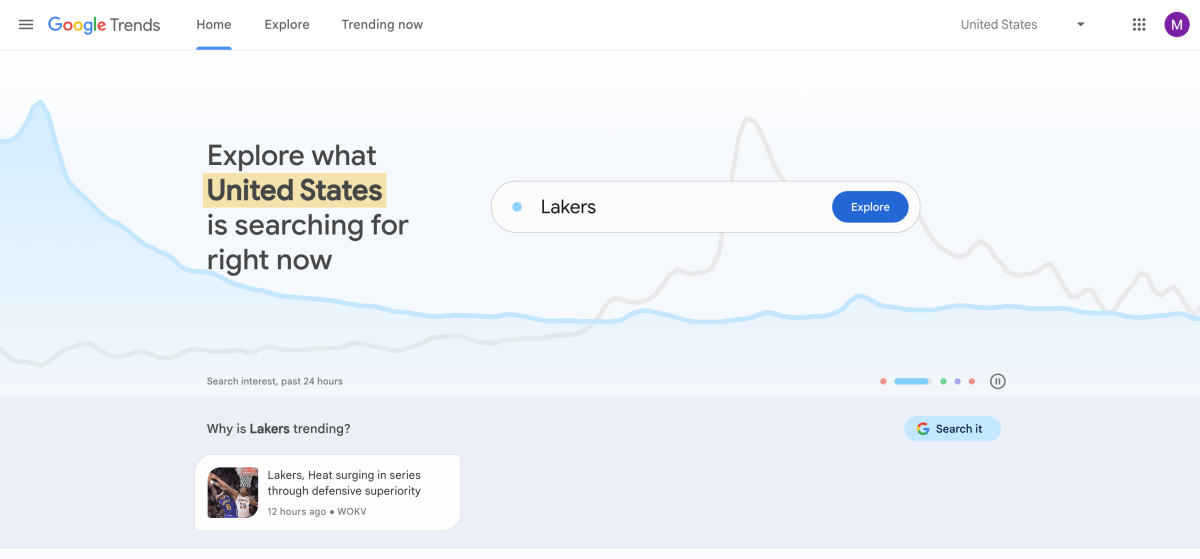
For even more ideas and inspiration, I use these tactics:
- Find my most successful blog posts to see what readers love.
- Seeing what other bloggers in my niche are doing (and how they’re doing).
- Repurposing old content into roundup posts.
- Looking back at past mistakes and sharing my learning experience.
By this point, I’ve usually filled up my content calendar for at least a few months. Need more ideas? Here are 14 quick ways to find blog post ideas.
How to write your first blog post in WordPress
Once you’ve decided on the first blog post you want to write, navigate to Posts > Add New from your WordPress Dashboard:

This will take you to the blog editor (also known as the Gutenberg editor):
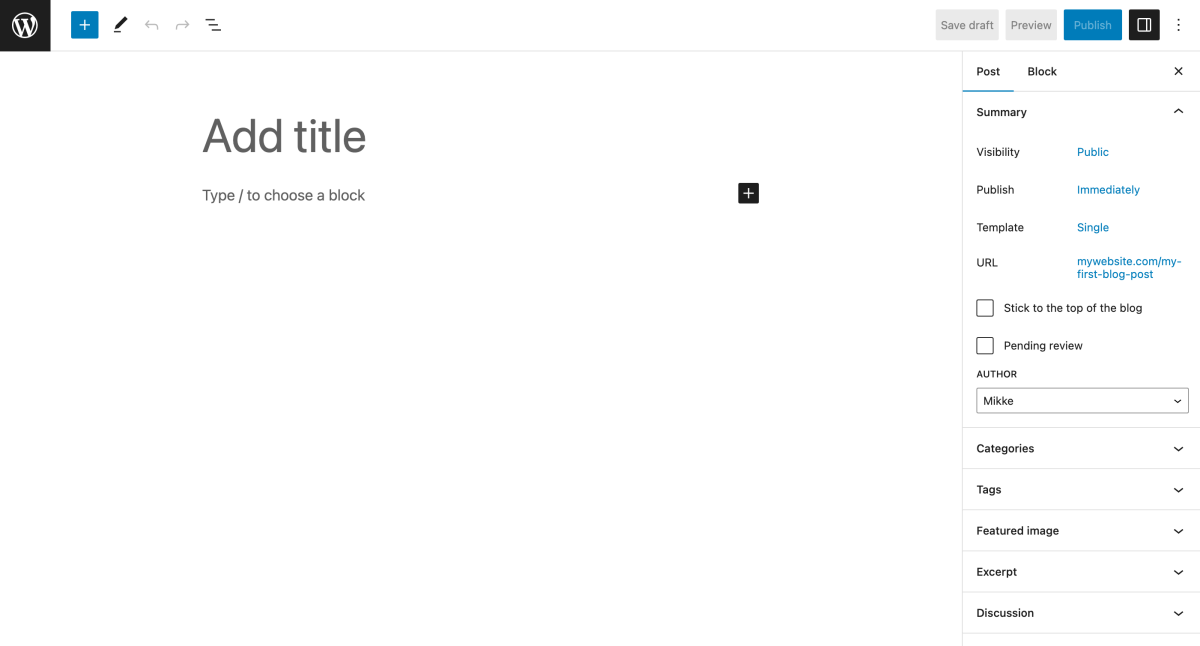
Write a blog post headline that attracts readers
Let’s start at the top, where you see a field for the post title:

The only reason people visit your blog is because they see an intriguing blog post headline, right?
Thus, you want to put some effort into learning how to write enticing, catchy headlines and – even more importantly – deliver what your headline promises.
Start by doing some research in your niche. Browse through other bloggers’ headlines and pay attention to these key points:
- Do they often include numbers?
- How many headlines start with “how to”?
- Do they capitalize the first letter of every word?
- What benefit words do you see, e.g. “easy”, “quick”, “instant”, “proven”?
- How many article headlines include parentheses?
Feel free to peruse my blog archives to see how I structure my blog post headlines.
Also, remember that you can adjust your headline in the future. For example, if you’re writing a blog post about the “best women’s summer yoga pants in 2024”, you should update the guide for 2025 and change the headline accordingly.
If you’re not 100% sure about your headline, head over to Google and search for your target keyword phrase. It’s perfectly OK to gather some inspiration from others in your niche, as long as you’re not copying their ideas.
Finally, use the free CoSchedule headline analyzer to craft the perfect headline easily. Just enter your title into the field and click Analyze Now to see tips to improve it:

Choose an SEO-friendly blog post URL (aka permalink)
Your blog post URL (or permalink) should always include the main keyword for your blog post.
Since you should only write one article for each target keyword phrase in your niche, you don’t have to worry about having duplicate permalinks.
Permalinks should be as easy to remember and read as possible. Consider using just your target keyword phrase as the permalink.
When you’re done writing your article and you’re ready to publish it, you can change the permalink in the Post settings:

Write a compelling blog post introduction
Once you have a rough outline for your blog post title, you should think about your introduction next.
Some bloggers like to write their introduction first, while others prefer to write it once they’re done with the actual body of their post.
Try both methods and see what suits you best. I suggest writing at least a rough outline for your intro before starting with your body.
Remember: Your blog post needs to solve a problem for your readers. Therefore, you should promise a solution in the introduction. Once you have a draft for your intro, it’s much easier to stay focused on that solution while writing your article.
So how do you write the perfect introduction, then?
One simple solution I’ve discovered so far is the Agree-Promise-Preview (or APP) formula. With the APP method, you divide your introduction into three blocks:
- Agree: Start with an idea your readers will agree with. Show them you understand what they’re struggling with.
- Promise: Paint a pretty picture of how your blog post can make their lives easier. Tell them how their world will be a better place when they keep reading and use your solution.
- Preview: Show your readers what they’ll get from your article. Use exact numbers or figures if possible and tell them what they can achieve after reading your post.
The quicker you catch your reader’s attention by establishing trust and relevance, the more likely they will stick around and share it with others.
Optimize the layout of your blog post (for readability)
Since this is your first blog post, I know it may feel difficult to know how to format your content.
Luckily, there are a few design and layout guidelines you can follow. It all boils down to making your blog post as easy to read and skim through as possible.
Because the sad truth is: People have short attention spans. If they can’t find what they’re looking for or if your blog post is one endless paragraph of text, they won’t keep reading.
Hence, design and layout matter just as much as your blog post content itself.
Here are a few key rules for structuring the perfect blog post layout:
- Make your blog posts readable:
Keep your colors, fonts, and layouts simple. Avoid distractions, and make the reading experience as enjoyable as possible. Your font size should be at least 16px. Use plenty of white space and keep your paragraphs short. - Break up your text:
Use headings to structure your blog post and lists to improve readability. If you can, use relevant images to break up the flow of your text. - Use bolding and italics sparingly:
Highlighting and emphasizing key parts is easy with bolding and italics. Only use them for extremely important words or phrases – less is more.
Proofread and check your grammar
The hard part is over now! You’ve finished writing, and we’re almost ready to publish.
But first, let’s improve readability even further by checking for any typos and grammar mistakes. Here’s a quick checklist you should go through:
- Check your spelling:
Take your time and read your post like it was written by someone else. Use a free grammar and spelling check tool for this to save time. - Preview the post:
Click the Preview button in the “Publish” menu widget in the upper right corner of the blog post editor. - Test your links:
In the preview window, check if all your links are pointing to the pages they should link to. - Remove any editing remarks:
Check that your post doesn’t have any editing notes you’ve added while writing and editing it.

Optimize your blog post for organic search (SEO)
Once you’ve written your first blog post, you’re almost ready to publish it!
Before you do, let’s make sure your blog post is SEO-friendly. This gives you a better chance of ranking well in Google’s search results for your target keyword phrase.
The free Yoast SEO plugin offers quick, actionable optimization suggestions for your blog post:

Take a few minutes to double-check whether your content fulfils the basic SEO guidelines and best practices.
Publish your first blog post
After you’re through with the SEO settings, create a category for your new blog post in the right-hand side settings by selecting Add New Category and naming it:
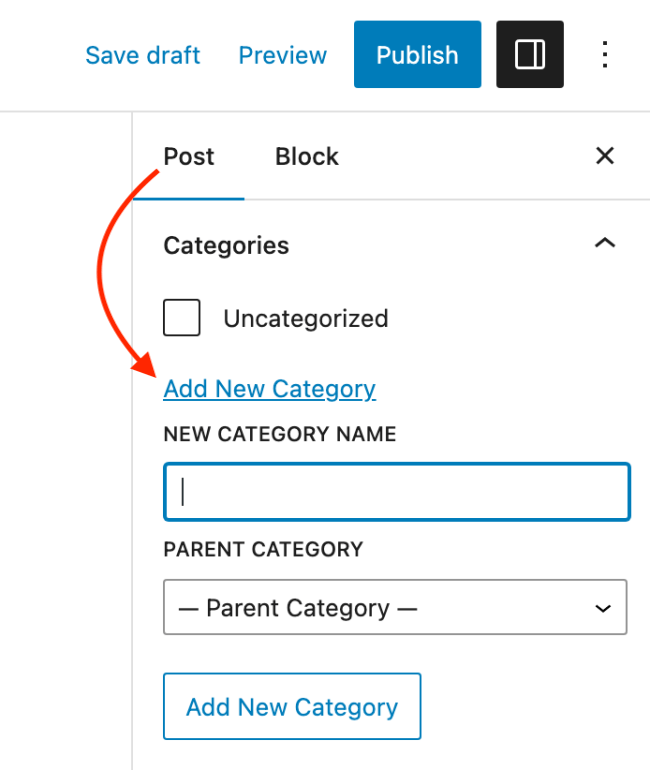
Once you’ve assigned a category to your blog post, hit Publish!
Congratulations! You just published your first blog post, yay!
We’ve come a long way in this guide. You’ve set up the technical parts of your blog, customized the design with a WordPress theme, and now published your first blog post. I’m glad you’re still with me!
By this point, you’re all set for creating high-quality blog posts that your readers will love.
Next, let’s think about what happens once you publish more and more content: promoting your blog posts, generating blog traffic, and ultimately making money from your blog.
Step 5: Promote your blog to get readers and traffic
Once you’ve written a bunch of great blog posts to share with your readers, you need to get visitors to your blog.
So what do you do when you’ve published a handful of blog posts? It’s time to promote your blog.
Let’s look at the best ways to share your blog posts and getting some eyeballs to your content. I’ve written a full guide to learning how to grow your blog traffic for a deep-dive into the strategies I’ve used to grow my blogs.
Use social media to promote your blog posts
The first place to turn when you want to find readers is social media.
Social networks like Instagram, Facebook, Twitter, YouTube, LinkedIn, Reddit, Snapchat and TikTok have billions of users worldwide.
That said, you want to find the platform that best suits your niche and target audience interests. Focus on one platform in the beginning. There’s no point trying to promote your blog posts on all social networks.
Which social network should you use?
Each social platform appeals to a certain niche and type of reader. Depending on the content you publish, you want to focus on the network where your target audience hangs out online.
Here’s what works best on each social network:
- Instagram: High-quality photos, stories, and quotes
- Facebook: Curated content and videos
- Twitter: Blog posts, quick news, and GIFs
- YouTube: Video content
- LinkedIn: Career news and professional content
- Pinterest: Visual content, high-quality photos, infographics, and step-by-step photo guides
- Reddit: Comments about popular topics in your blog niche
- TikTok: Short videos, step-by-step tutorials, and quick stories
Helpful tools to automate your social media promotion
The best way to generate blog traffic from social media is to stay consistent with promoting your content. For most networks, that means sharing content and tips every day.
Hence, managing your social media promotion can be a lot of work.
Luckily, some social networks allow you to schedule your posts in advance. For example, Pinterest, Facebook, and Twitter let you create a post and choose when you want to publish it. This way, you can plan and schedule your social media sharing for 1–2 weeks in one sitting.
There are lots of tools that help you fully automate your social media posts. With the right tool, you can save heaps of time and promote all your posts in just an hour or two a week.
Here are my favorite social media automation tools:
- Buffer: One of the easiest ways to schedule social shares in advance for Instagram, Facebook, Twitter, Pinterest, and LinkedIn. I love their browser plugin for quickly adding relevant posts I find online to my social sharing queue.
- Tailwind: The best automation tool for Instagram and Pinterest. You can start with the free plan to get familiar with the key features and upgrade to a paid plan to unlock the full toolkit.
- Hootsuite: If you want something a bit more advanced, Hootsuite is a powerful social sharing, scheduling, and automation platform. It’s a lot to take in for beginners, but keep it in mind for the future.
Remember: you’ll need to experiment and see which social network will perform best for you and your type of content. Be mindful of your blog target audience and find out which networks they use the most.
Use Pinterest to grow your blog traffic
I usually don’t play favorites when it comes to blog promotion tools and social media. But Pinterest has earned a dedicated spot in this list.
Back in 2018, I was struggling to grow my first blog I started two years earlier. My content was top-notch and I was getting great feedback from my readers. Google was already sending significant traffic to my blog. But I wanted more.
At that point, I turned to Pinterest. I had never used it before, but people kept telling me how great it was for generating free blog traffic.
If you’re not familiar, Pinterest isn’t exactly a social network. It’s rather a visual search engine. Since I was familiar with search engine optimization for Google, I knew mastering Pinterest would be fun.

I developed a simple but powerful Pinterest marketing strategy based on my own findings. Within two months, my blog traffic grew by 200%. Needless to say, I fell in love with Pinterest and I still use the same strategy today.
The biggest secret to success on Pinterest is consistency. For best results, you need to save new, relevant content to your Pinterest boards daily. Of course, that’s time-consuming in the long run. To save time, I use the Tailwind scheduling tool for promoting my blog posts on autopilot.
With Tailwind, you can choose how many pins you want to share daily and schedule them in advance. The tool automatically picks the best time slots for your posts, so that as many people as possible see your content on Pinterest.
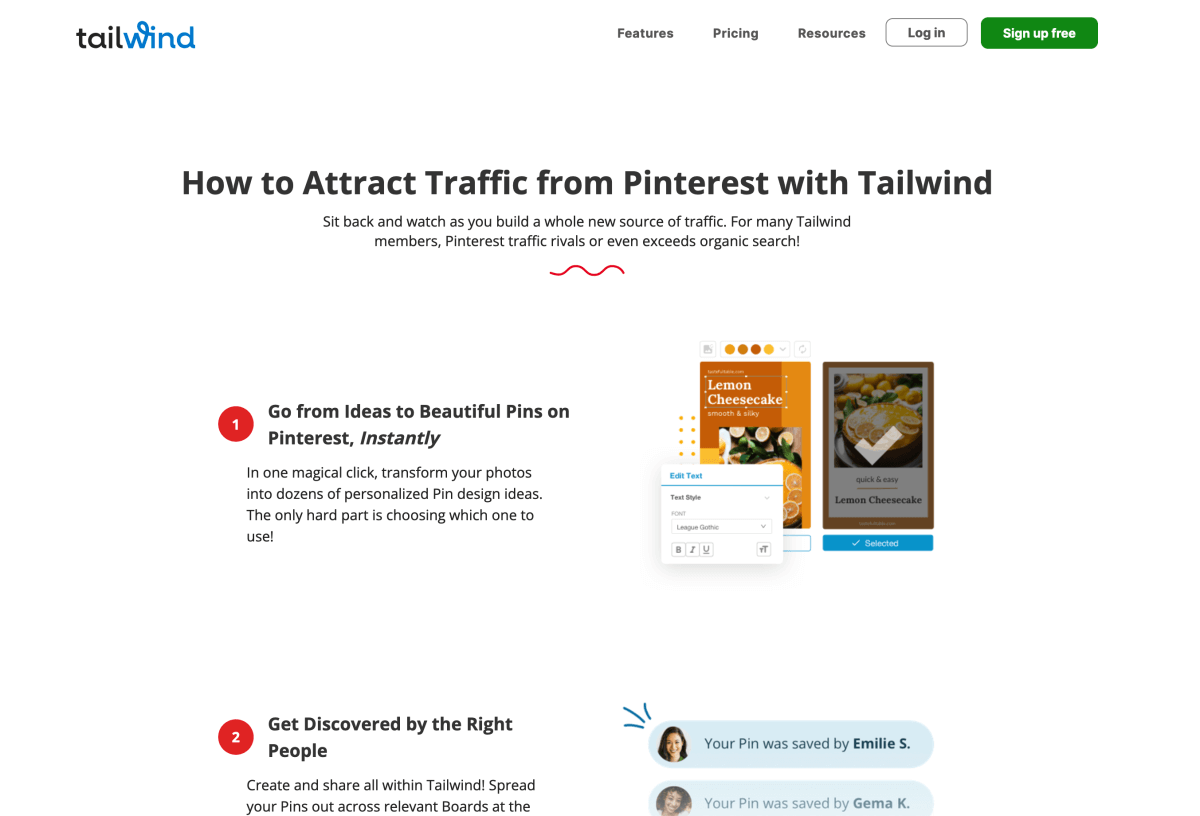
For more details, here’s my complete Pinterest blog promotion strategy guide for you.
Use e-mail marketing to grow your blog audience
Finding new readers for your posts time after time is your primary goal, but building a list of loyal followers using e-mail marketing is just as important.
E-mail marketing means that you collect e-mail addresses from your readers and use that direct contact channel to notify them about new posts or other topics per e-mail.
Your e-mail subscribers keep coming back to your blog. This way, you get more visitors and can build a closer relationship with your readers.
I recommend you sign up and start building your e-mail list right away.
I use MailerLite for all my blogs for e-mail marketing. They offer a free plan for up to 1,000 subscribers, which is more than enough for at least the first few months. I’ve written a full MailerLite review with all the details.
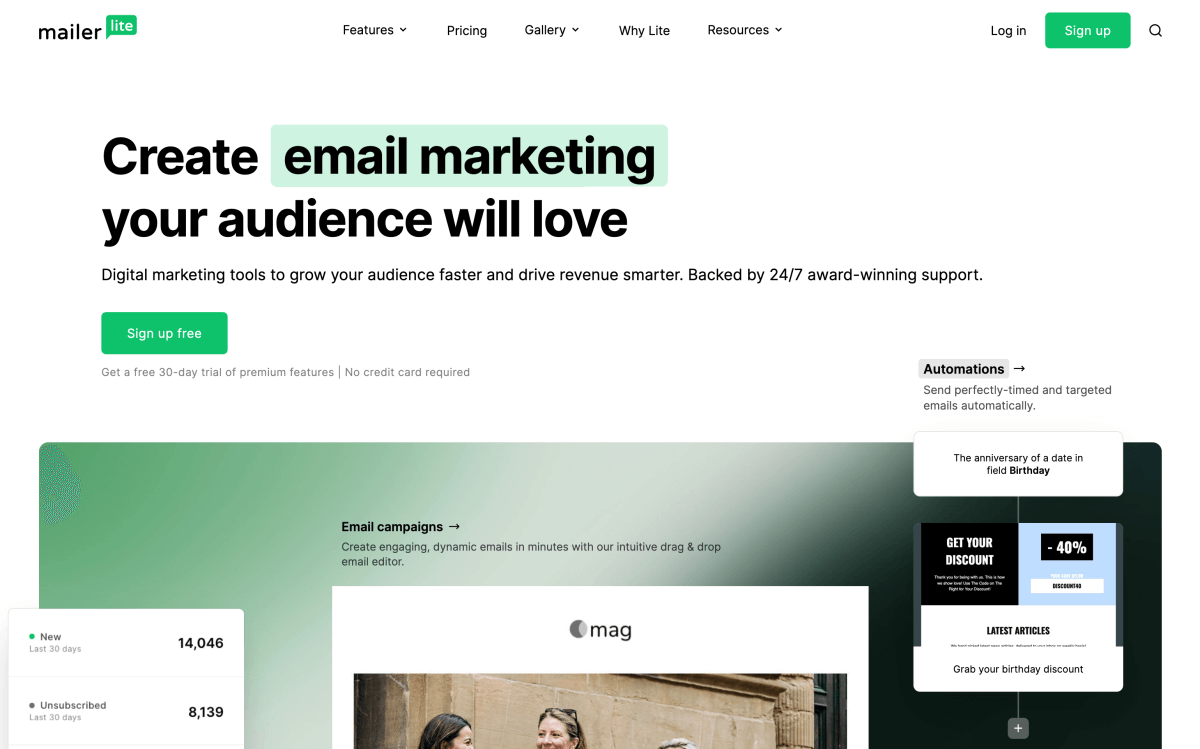
You can sign up for their free plan here in 5 minutes and create a simple sign-up form to embed on your blog right away.
MailerLite offers a full library of helpful step-by-step video tutorials to get you started. Plus, even the free plan gives you full access to their 24/7 support for the first 30 days.
Learn Search Engine Optimization fundamentals (SEO)
SEO or search engine optimization is one of the best ways to generate free, organic traffic to your blog.
I know SEO might feel complicated and technical, but it’s much easier than you may think. Even if you’re entirely new to blogging, you can learn the basics of SEO in a few hours.
The only thing you need to understand is: People use Google to find solutions, answers, and information.
Hence, you need to know what your blog target audience is struggling with. Once you know what they are searching for, you can write blog posts that deliver easy, practical solutions to their problems.
As long as your blog posts offer the best, most in-depth information for your niche and target keyword phrase, your Google rankings will improve over time.
For a detailed introduction with helpful SEO tips and strategies, head over to my free guide on what SEO is.
Guest blogging on other blogs, Quora, and Medium
One way to get your voice heard is by sharing your thoughts on other blogs and publishing platforms. Guest blogging on other relevant sites is one of the best ways to connect with an already established audience.
Obviously, you want to look for places where your audience spends time and build your own presence there. Whether that’s other blogs, discussion forums, or online communities – you need to know where your readers hang out online.
How to land your first guest post
Chances are that most blogs in your niche accept guest posts.
The idea of a guest post is you propose a relevant topic to another blogger, write a full article, and publish it on their blog website.
Here’s a simple method to find guest posting opportunities in your niche:
- Head over to Google.
- Search for “[your blog niche] guest post”.
- Browse interesting blog websites that are relevant to your audience.
- Review their guest post guidelines.
- Get in touch with them to propose a guest post idea.
- Submit a high-quality article to the platform.
Remember to add a backlink to your blog – this is the whole point of publishing aguest posts. Backlinks improve your rankings on Google and your blog’s overall authority. Google loves it when other domains in your niche link to your blog.
How to republish your content on Quora and Medium
If a full-scale guest blogging campaign isn’t your thing, try reposting your content on Quora or Medium.
Quora is a question and answer site that allows anyone to respond to other user’s questions and queries. Search for relevant topics in your niche and find questions that you’ve already written about on your blog.
Post detailed, valuable answers and add a link to your blog post for more details. Be careful not to over-promote your own content – only add backlinks to your website where it feels natural and adds value.

Medium is a platform where you can publish original content or re-publish existing blog posts. The more readers your articles attract, the more likely they are to be featured in curated feeds.
You can even look for a Medium Publication popular in your niche and submit your blog post to them to reach an even larger audience.
Link to other relevant blogs
When you’re short of ideas for great blog posts, why not consider writing a response to a post on another blog?
It’s one of the best ways to create connections to other bloggers around your topic and to create more discussion within your target audience, too.
If you choose to try this method, I’d recommend writing a post where you add something to the post on that other blog. It’s easier to cultivate a positive atmosphere and a supportive community within your field rather than writing a post where you simply disagree with the other post.
When you’re writing the post, make sure you add a link to the post you’re responding to. That way, the other blogger will receive a notification about your post and will most likely read what you have to say.
And if that wasn’t good enough, they’ll perhaps even write you a comment and inser a link to your content into their own blog post.
Comment on other blogs in your niche
Part of the beauty of blogging is the possibility to connect with your readers by asking them to share their thoughts by writing a comment below your post.
And this works both ways: You can comment on other blogs, too.
When you write a comment to a blog post, you can often add a link back to your own blog. This is an opportunity that you should think about carefully before using it because it’s easy to use it for spamming.
Hence, only leave comments that are useful and add real value to the conversation.
For example, you could share a personal, interesting perspective on the blog post. Or if you see someone asking a question in the comments, you can write them a helpful, in-depth answer – unless, of course, the question is aimed at the author of the blog.
All in all, you should use this method with caution. When it comes to commenting on other blogs to promote yours, less is more.
Publish content regularly and consistently
Needless to say, the blog promotion methods above require a lot of effort and planning. Since you only have so many hours in a day, sometimes it’s a better idea to use your time for creating more content for your blog.
Writing new blog posts is the cornerstone of your overall blog promotion strategy. Publishing new content consistently is the only way to make sure your readers will find what they are looking for every time they visit your blog.
Publish new, valuable content as often as you can. But stick to a realistic publishing schedule that you can follow consistently.
If you have a full-time job and a family with three kids, you probably can’t spend hours every day writing for your blog. On the other hand, if you only publish new content once a month, your readers are likely to forget about your blog altogether.
Therefore, you need to find the right balance for both yourself and for your readers. Don’t burn yourself out thinking you must post every day. But at the same time, consider how often your readers would like to hear from you.
Step 6: Make money from your blog
You’ve come all the way from laying the very first foundation for your blog to creating amazing content and promoting your blog to grow it.
Everything you’ve learned so far is enough to keep you busy for weeks and months. Keep listening to your audience, writing high-quality blog posts, and promoting your blog content on relevant social networks.
But I know you’re probably starting a blog to earn some extra income. After all, blogging is a fantastic opportunity to earn passive income while helping your readers.
Just remember this: It takes time to generate significant income from your blog. Hence, blogging isn’t a get-rick-quick scheme.
Although you may see bloggers share their six-figure income reports, remember that they’ve worked very hard to achieve that level of income. That kind of success doesn’t happen overnight.
Unless you have a huge audience somewhere already, you can’t expect to make money right away. Therefore, monetization should not be your #1 focus at this point, but rather something to work towards.
Nevertheless, it’s good to have an overview of which ways you can make money blogging as you start your journey. Some monetization strategies will be easier to implement than others, and some strategies work better for certain niches.
Here are 5 popular ways to make money from your blog:
1: Affiliate marketing
Affiliate marketing means you sell someone else’s products or services and make a commission for every purchase. If cone correctly, it can be a fantastic source of passive income that keeps paying off for months and years to come.
Affiliate marketing is how I earned my very first dollars on my first blog and how I now make a full-time income blogging. About 85% of my total blog income is from affiliate sales.
The steps to successful affiliate marketing are simple:
- Choose a product you use and trust
- Join the affiliate program for that product
- Share your success story with the product (create top-notch blog articles)
- Convince your readers why they need the product
- Drive traffic to your blog content
- Earn commission when readers buy through your affiliate link
To learn more, check out my complete Affiliate Marketing for Dummies guide.
2: Display ads
The idea with placing display ads on your blog is simple:
- You sell advertising space
- Your readers see an ad on your blog
- You earn a commission for every view or click (or both)
Ad income is 100% passive. Once you’ve set up your ads, you will make money with display ads while you sleep.
You can choose from dozens of top ad networks for bloggers to place ads on your blog easily.
As you generate more traffic to your blog, your income will grow gradually.
3: Selling your own products
The idea behind rarning money from your blog by selling your own products is simple:
- Listen to your audience
- Learn what they’re struggling with
- Create a product that solves a real problem for them
To learn more about your audience, I recommend mastering affiliate marketing before creating your first product. That allows you to learn what types of products your readers need. Once you know exactly what they want, it’s easier to create the perfect product.
For example, some time ago I promoted a Pinterest marketing guide as an affiliate partner, and I earned about $2–5 per sale.
Even if I sold 10 products daily, my income would be $60–300/month. That’s a great start, but it wouldn’t even cover my food expenses.
So I thought: OK, my readers love getting more blog traffic from Pinterest. I just have to find out what they struggle with the most.
This is what I knew:
- My audience loves blog traffic.
- They love using Pinterest to drive free traffic to their websites.
- Almost everyone was using Pinterest the wrong way.
- I have a Pinterest strategy opt-in and a few thousand subscribers on my list.
- A team of Pinterest reps would help me confirm my techniques.
The next step was easy: I needed to craft a top-notch product to help my readers understand how Pinterest marketing really works. My insider contacts at Pinterest were more than happy to help me out.
That’s how my popular Smart Pinterest SEO e-book was born.
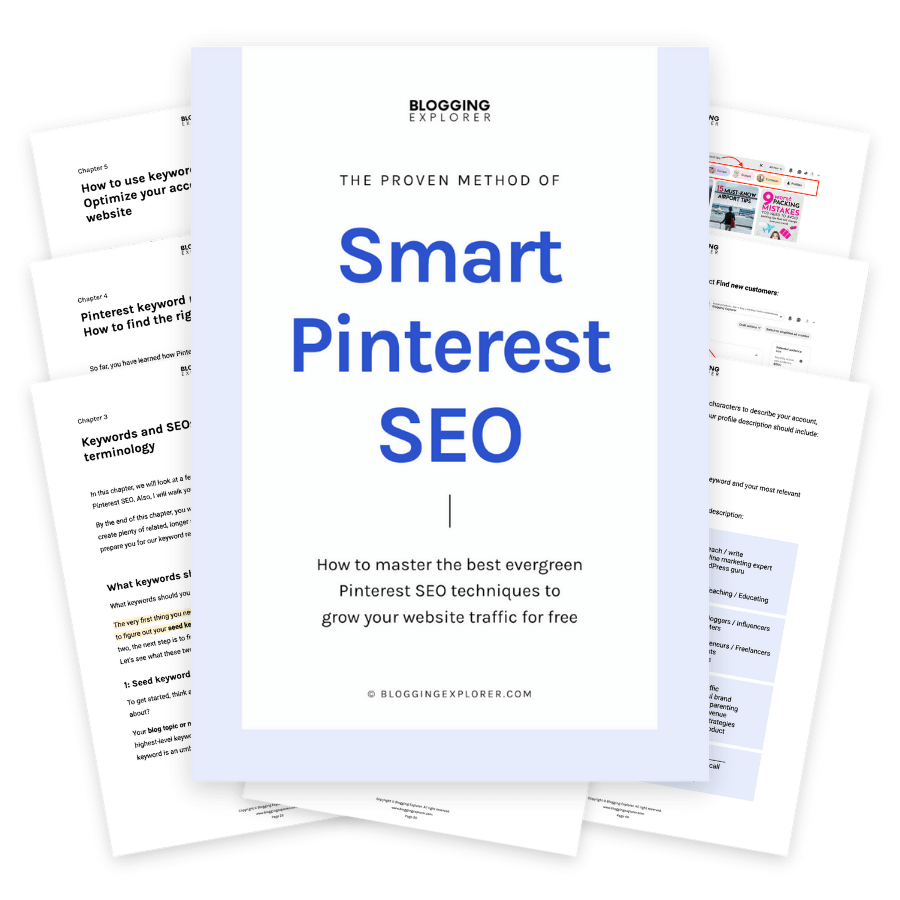
Overnight, my $2/sale commission became $48/sale.
The best part? With your own products, you get to keep 100% of the revenue.
Also, you can gather feedback directly from your customers and improve your product continuously. Hence, make sure you pay attention to what they say. That feedback can be a goldmine for further product ideas.
Here are a few ideas for products you can sell:
- e-books
- online courses
- graphics (photos, templates)
- WordPress themes and plugins
The easiest way to sell digital products is to use a platform like SendOwl. Their tool allows you to set up your product and create a simple sales page within minutes. They handle the payments and take care of the technical stuff. I can’t recommend them enough.

4: Freelancing (offering your own services)
If you want to start earning money from your blog as quickly as possible, then selling your services and skills is the easiest option.
All you need to land a freelance client is a strong pitch and relevant skills. Hence, starting a blog (first) will help significantly with reaching your target clientele.
To offer your services to clients, you want to build out your key pages (About, Contact, Hire Me) and showcase at least a few work samples from past, relevant projects. Make sure to include reviews from past clients or partners if you can.
If you don’t have any work samples yet, don’t worry. Create your own sample articles or designs and present them on your own blog website as if they were a real-world project you got paid to produce.
Here are a few skills you can sell as a freelance service:
- Writing
- Design
- Marketing
- Social media management
- Web development
- WordPress development
- SEO and content marketing
- Project management
- Virtual assistance
You can easily find small freelance jobs on websites like Upwork.com or Freelancer.com.

It might take some work to land your first job and your rate might be lower than you expect. But once you have your first stellar review from a client, getting your next job will be much easier.
5: Paid sponsorships and brand collaborations
Another powerful method to make money blogging is to publish paid or sponsored content on your blog.
The idea behind paid content is simple: You team up with a brand and give them an opportunity to publish an article with promotional content for their products or services.
In other words, you’ll write a blog post where you share your thoughts or experience about a specific product to promote it.
Most often, sponsored articles are:
- Informative reviews
- Assessments of products or services
- Comparison articles
- Analyses of companies or brands
- Endorsement articles
- Informational posts about the company or brand
Thus, the main goal of paid content is to help increase the outreach of a brand.
If a company can see that your readers represent their target demographic, they might be interested in publishing paid content on your blog.
The biggest issue with paid content is the risk that your blog will lose your personal tone and vibe.
If you’re an established blogger in your niche, your readers “know” you. They’re familiar with your style and how you write in general.
Thus, publishing paid content can quickly make your articles too promotional for your audience. And since each sponsored article translates into higher income, it’s easy to overdo it.
If that happens, your blog will become a glorified billboard. Your readers will notice that you’re not trying to help them anymore like you used to.
With that said: When it comes to sponsored blog posts, less is more.
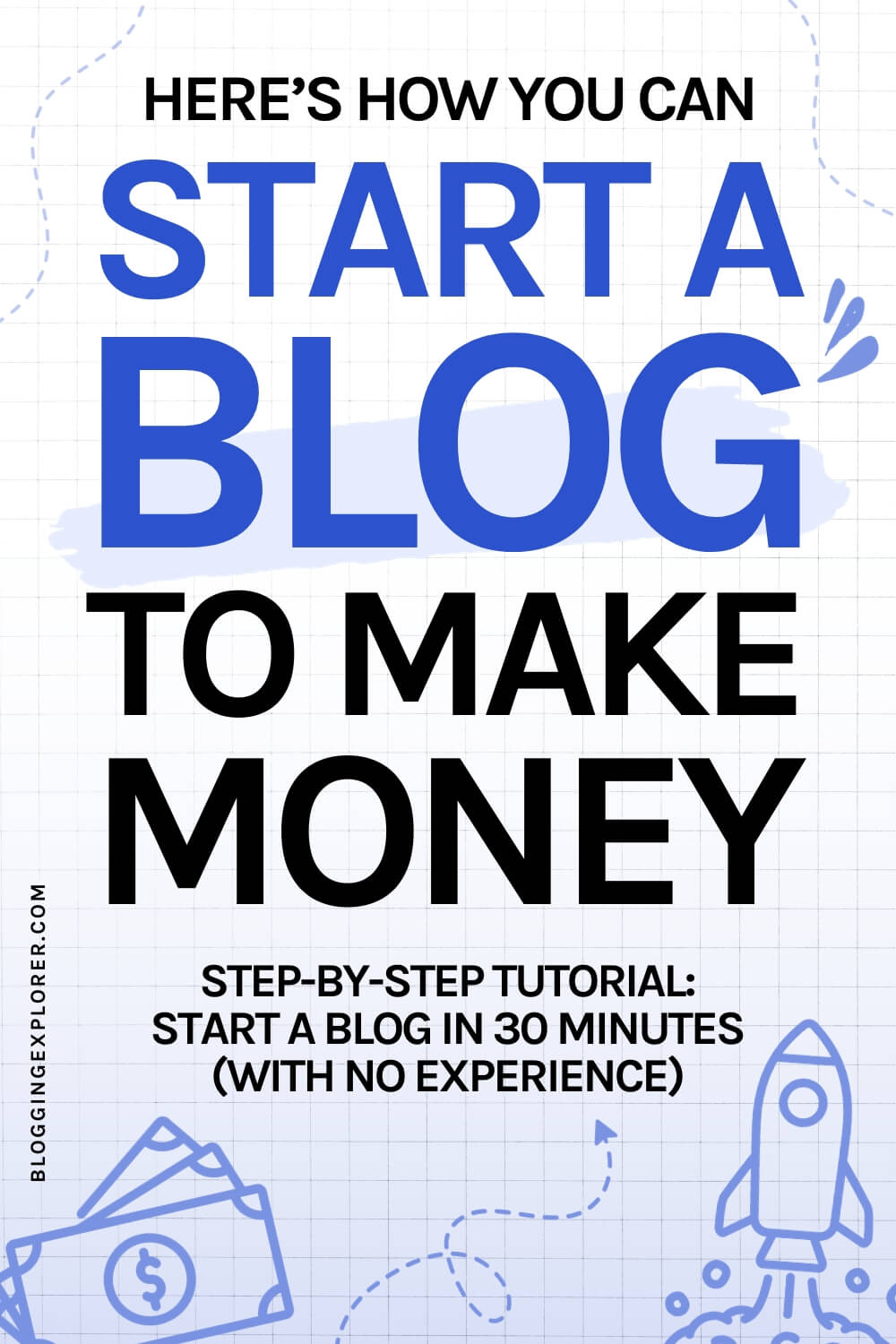
How to start a blog and make money in 2024: Final thoughts
Starting a successful blog is all about staying persistent and focussed on your long-term goals. If you want people to read your blog posts, you need to know what they need and create helpful, targeted content that makes their lives easier.
Write top-notch, value-packed blog posts that blow their socks off! Show how enthusiastic you are about your blog topic, connect with your readers, and put your personal touch into every blog post you publish.
Be mindful of why you’re starting a blog. How do you want your life to change through blogging? Perhaps you want to earn a side income from your blog to achieve more financial freedom and flexibility in life?
Whatever your “why” is, don’t lose sight of it. At the end of the day, it’s going to keep you motivated for years to come.
Once you get the ball rolling, your blog traffic will grow and you can start to monetize your blog.
I created this free guide because starting a blog has been one of the most empowering decisions I’ve made in my life. It helped me feel more confident in what I do and who I am, simply by sharing my experience with the world.
And I couldn’t be more excited to guide you through your own blogging journey, helping you with what I’ve learned so far.
I hope you’re feeling as excited as I am, confident enough to take the leap and start a blog of your own, too.
I’d love to have you join my free 7-day blogging course that builds on this guide. I’ll share further tips and resources in the course, diving deeper into topics like blog traffic, monetization, and more.
Summing it up: How to start a blog and make money (Step-by-step guide for beginners)
Let’s sum up the step you need to take to start a profitable blog:
- Choose your blog topic and name
- Get your blog online (web hosting and WordPress)
- Customize your blog design (with a WordPress theme)
- Write your first blog post
- Promote your blog to get readers and traffic
- Make money from your blog
Ready to start? Awesome!
Follow this step-by-step guide to starting a blog and you’ll achieve your goal sooner than you expect.
If you’re looking for some extra reading to help along on your blogging journey beyond this guide on how to start a blog, then check out these popular guide I’ve created for you:
- How Much Does It Cost to Start a Blog?
- How to Find the Best Blog Hosting? Blog Hosting Review
- 7 Things You MUST Do Before You Launch Your Blog
- Growing Your Blog: 7 Powerful Blog Traffic Tools
- Pinterest Strategy Guide: How to Grow Your Traffic With Pinterest
- Pinterest SEO: The Ultimate Guide for Massive Blog Traffic
- What is Search Engine Optimization? SEO for Bloggers
- What To Do When Your Blog Traffic Is Low? 13 Powerful Traffic Hacks
- How to Start an Email List as a Beginner Blogger: 7 Easy Steps
- How to Make Money Blogging for Beginners: Step-by-Step Guide
- How Do People Make Money Blogging?
- How to Monetize Your Blog? 5 Powerful Ways to Make Money Blogging
- 15 Reasons Why Your Blog Isn’t Making Money (And How To Fix Them)
- Affiliate Marketing for Dummies: How to Make Money Step-by-Step
- 11 Best Ad Networks for Bloggers
- Increase Display Ad Income: 15 Easy Tips For More Passive Income
- Best WordPress Themes For Blogs (Free and Paid)
- 10+ Best WordPress Plugins for Bloggers (All Free)
- What Is the Difference Between WordPress.org vs WordPress.com?
- 160+ Profitable Blog Niche Ideas That Make Money
- How to Find the Perfect Blog Topic: Step-by-Step Beginner’s Guide
- 14 Quick Ways to Find Blog Post Ideas for Writers
- How to Write a Great Blog Post (Every Time): The Ultimate Guide
- 6 Time-Saving Tips to Write Blog Posts Faster
- How to Treat Your Blog Like a Business? 8 Practical Tips
- 6 Worst Blogging Mistakes (And How to Avoid Them)
- Feeling Overwhelmed With Blogging? 6 Practical Tips to Recover Instantly
Now, I want to know how you’re feeling and how your blogging journey is going so far. Ask any question or drop me a line in the comments below!
